Paul van Yperen's Blog, page 391
February 15, 2015
Marlene Dietrich
Marlene Dietrich (1901-1992) was the first German actress who became successful in Hollywood. Throughout her long career, she constantly re-invented herself. In 1920s Berlin, she started as a cabaret singer, chorus girl and film actress. In the 1930s, she became a Hollywood star, then a World War II frontline entertainer, and finally she was an international stage show performer from the 1950s till the 1970s. Now we remember her as one of the icons of the 20th century.
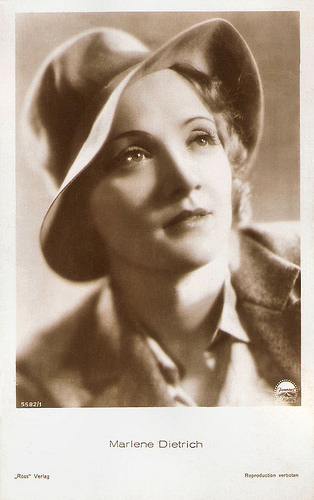
German postcard by Ross Verlag, no. 5582/1, 1930-1931. Photo: Paramount.
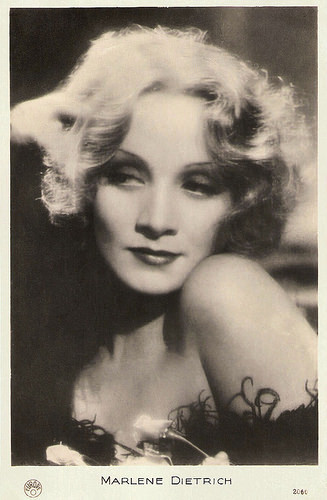
French postcard by Europe, no. 2060. Photo: Paramount. Publicity still for Shanghai Express (Josef von Sternberg, 1932).
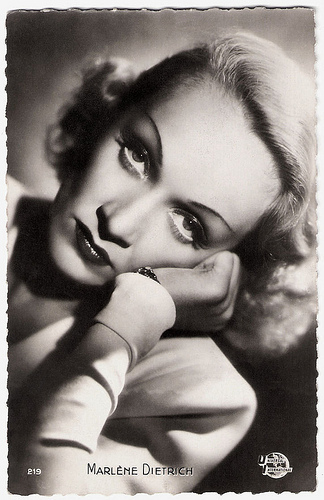
French postcard by Editions P.I., presented by NV Victoria, Brussels, no. 219. Photo: Universal International.
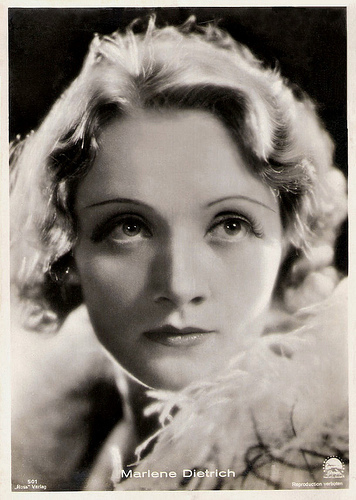
German postcard by Ross Verlag, no. 501. Photo: Paramount. Publicity still for Morocco (Josef von Sternberg, 1930).
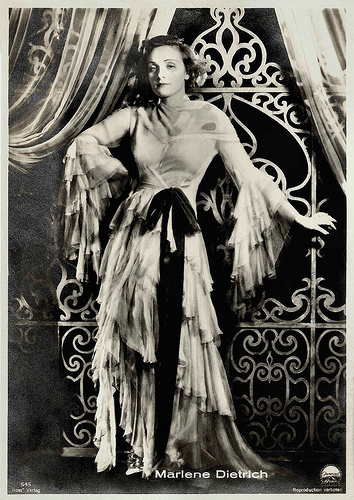
German postcard by Ross Verlag, no. 545. Photo: Paramount.
Chorus Girl
Marie Magdalene Dietrich was born in Berlin-Schöneberg, Germany, in 1901. She was the younger of two daughters of Louis Erich Otto Dietrich and Wilhelmina Elisabeth Josephine née Felsing.
Her mother was from a well-to-do Berlin family who owned a clock making firm and her father was a police lieutenant. He died in 1911. His best friend, Eduard von Losch, an aristocrat first lieutenant in the Grenadiers courted Wilhelmina and eventually married her in 1916. He was killed on the Russian front in 1918.
The young Marie Magdalene and her elder sister, Elisabeth, were brought up strictly in an upper-middle-class Prussian home. It would be this influence which would shape her acting career and her life as a citizen in years to come.
Dietrich attended school in Berlin and Dessau from 1907 to 1919. She studied violin and became interested in theatre and poetry as a teenager. Her dreams of becoming a concert violinist were cut short when she injured her wrist.
In 1921, she auditioned unsuccessfully for Max Reinhardt's drama academy, but she soon found herself working in his theatres as a chorus girl and playing small roles in dramas.
The next year she played a part in the silent film So sind die Männer/The Little Napoleon (Georg Jacoby, 1922). On the set of another film, Tragödie der Liebe/The Tragedy of Love (Joe May, 1923), she met production assistant Rudolf Sieber. They were married in 1923. Her only child, daughter Maria Elisabeth Sieber, later billed as actress Maria Riva, was born in 1924.
Throughout the 1920s Marlene continued to work on stage and in films both in Berlin and Vienna. She attracted most attention in stage musicals and revues, such as Broadway and Es Liegt in der Luft/It's in the Air.
By the late 1920s, she was also playing leading parts in such films as Café Elektric/Cafe Electric (Gustav Ucicky, 1927) with Willi Forst , Ich küsse Ihre Hand, Madame/I Kiss Your Hand Madame (Robert Land, 1929) with Harry Liedtke , and Die Frau, nach der man sich sehnt/The Woman One Longs For (Kurt/Curtis Bernhardt, 1929) opposite Fritz Kortner .
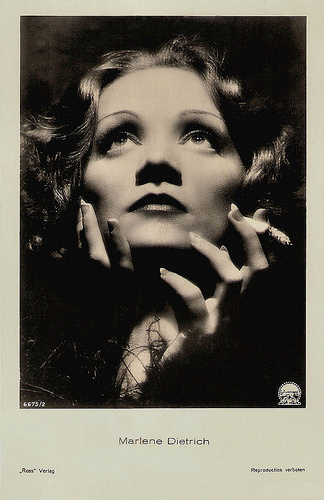
German postcard by Ross Verlag, no. 6673/2, 1931-1932. Photo: Don English / Paramount. Publicity still for Shanghai Express (Josef von Sternberg, 1932).
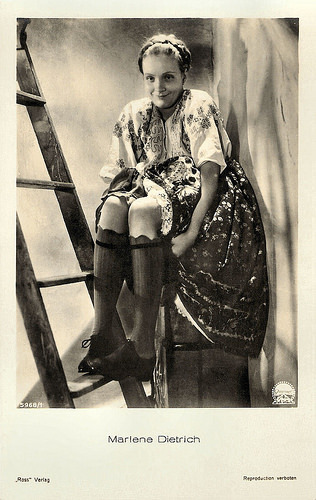
German postcard by Ross Verlag, no. 5968/1, 1930-1931. Photo: Paramount. Marlene Dietrich in the film The Song of Songs (Rouben Mamoulian, 1933).
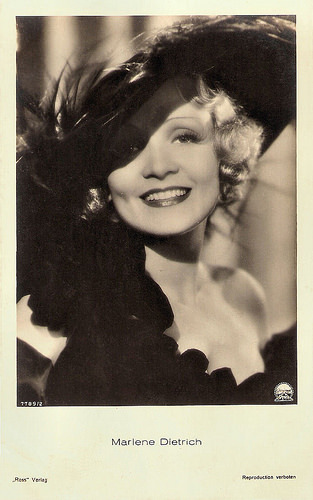
German postcard by Ross Verlag, no. 7789/2, 1932-1933. Photo: Paramount. Marlene Dietrich in the film The Song of Songs (Rouben Mamoulian, 1933).
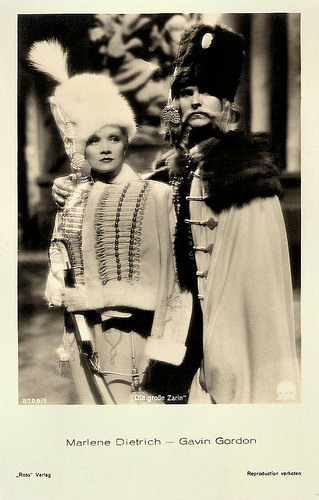
German postcard by Ross Verlag, no. 8709/1, 1933-1934. Photo: Paramount. Publicity still for The Scarlet Empress (Josef von Sternberg, 1934) with Gavin Gordon.
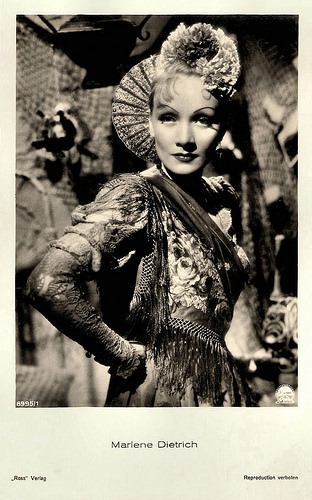
German postcard by Ross Verlag, no. 8995/1, 1933-1934. Photo: Paramount. Publicity still for The Devil Is a Woman (Josef von Sternberg, 1935).
Lola-Lola
In 1929 Marlene Dietrich played her breakthrough role of Lola-Lola, a cabaret singer who causes the downfall of Immanuel Rath ( Emil Jannings ), a hitherto respected schoolmaster, in the Ufa production Der blaue Engel/The Blue Angel (Josef von Sternberg, 1930).
Josef von Sternberg thereafter took credit for having ‘discovered’ her. The film is also noteworthy for introducing her signature song Falling in Love Again. On the strength of Der blaue Engel's success, and with encouragement and promotion from Von Sternberg, Dietrich then moved to Hollywood. She left her husband and daughter behind.
Paramount sought to market her as a German answer to MGM's Swedish sensation Greta Garbo . Her first American film, Morocco (Josef von Sternberg, 1930) opposite Gary Cooper earned her her only Oscar nomination.
Between 1930 and 1935 she was the star of six films directed by von Sternberg at Paramount: Morocco (1930); Dishonored (1931), about a spy who betrays her country for love of a worthless man ( Victor McLaglen ); Shanghai Express (1932), a melodrama in which she is a China Coast prostitute who offers herself to a warlord (Warner Oland) to save the life of a former lover ( Clive Brook ); Blonde Venus (1932), a mother-love soap opera;, The Scarlet Empress (1934), an opulent and visually stunning melodrama about a lascivious Catherine the Great; and The Devil Is A Woman (1935), an erotic tale about a soldier-corrupting vamp in turn-of-the-century Seville.
Wikipedia describes how Von Sternberg worked very effectively with Dietrich to create the image of a glamorous femme fatale: "He encouraged her to lose weight and coached her intensively as an actress – she, in turn, was willing to trust him and follow his sometimes imperious direction in a way that a number of other performers resisted. A crucial part of the overall effect was created by Von Sternberg's exceptional skill in lighting and photographing Dietrich to optimum effect — the use of light and shadow, including the impact of light passed through a veil or slatted blinds (as for example in Shanghai Express) — which, when combined with scrupulous attention to all aspects of set design and costumes, make this series of films among the most visually stylish in cinema history."
Because it displayed her beauty most effectively, The Devil Is a Woman was her particular favourite. But after the dismal failure of The Devil Is A Woman, Paramount fired Von Sternberg, and the star and director would never work together again.
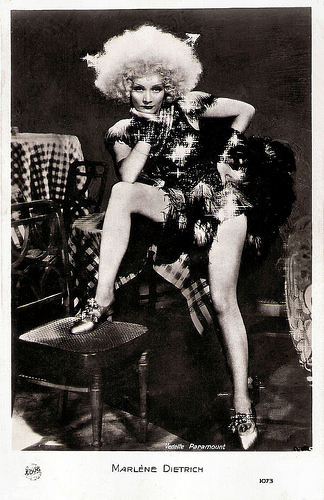
French postcard by EDUG, no. 1073. Photo: Paramount. Publicity still for Blonde Venus (Josef von Sternberg, 1932).
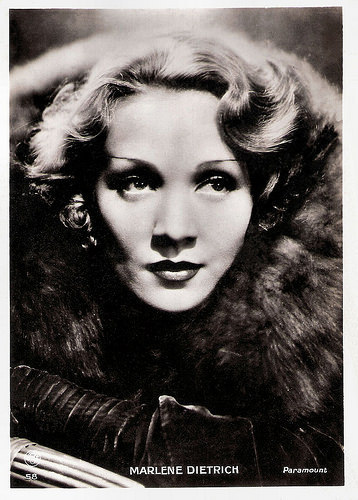
French postcard by Europe, no. 58. Photo: Paramount. Publicity still for Shanghai Express (Josef von Sternberg, 1932).
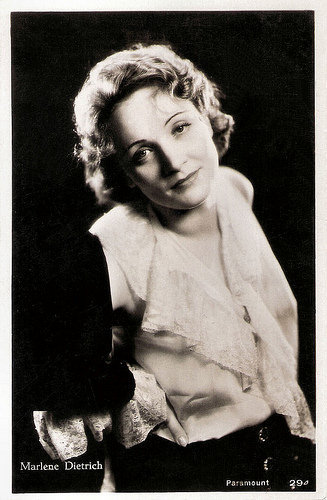
Dutch postcard, no. 294. Photo: Paramount.
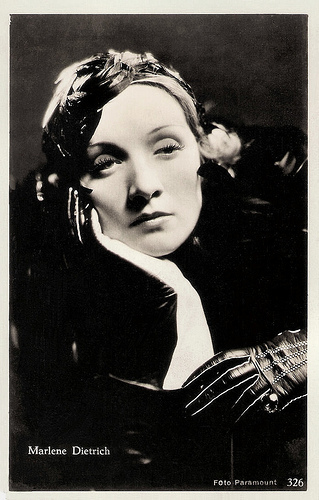
Dutch postcard, no. 326. Sent by mail in the Netherlands in 1934. Photo: Paramount. Publicity still for Shanghai Express (Josef von Sternberg, 1932).
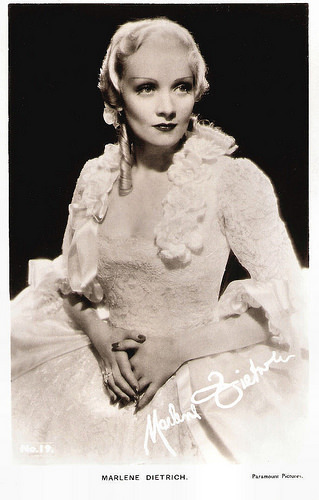
British postcard by Film-Kurier Series, London, no. 19. Photo: Paramount Pictures. Publicity still for The Scarlet Empress (Josef von Sternberg, 1934).
Box Office Poison
Without Von Sternberg, Marlene Dietrich made her first comedy, Desire (Frank Borzage, 1936). It was a satire about an urbane jewel thief (Dietrich) who steals a choice necklace from a Parisian jeweller and, in efforts to keep it, becomes involved with a hayseed Detroit engineer (Gary Cooper).
Although Dietrich's salary in the mid 1930s was enormous, she was never listed among the top ten box-office attractions, and depression-era audiences often felt she was preposterously exotic. She was even labelled 'box office poison' after Knight Without Armour (Jacques Feyder, 1937) proved an expensive flop.
In 1939, her stardom revived when she played the freewheeling saloon entertainer Frenchie in the comic Western Destry Rides Again (George Marshall, 1939) opposite James Stewart. Hollywood's attempt to make her more 'ordinary' worked. The film also introduced another favourite song, The Boys in the Back Room.
She played a similar role with John Wayne in The Spoilers (Ray Enright, 1942).
In December 1941, the US had entered World War II, and Dietrich became one of the first celebrities to raise war bonds. She toured the US from January 1942 to September 1943 and it is said that she sold more war bonds than any other star. During two extended tours for the USO in 1944 and 1945, she sang and performed the singing saw for Allied troops on the front lines in Algeria, Italy, England and France.
For musical propaganda broadcasts designed to demoralize enemy soldiers, she recorded a number of songs in German, including the ballad Lili Marleen. The troops loved her.
In 1947, she was awarded the Presidential Medal of Freedom by the US for her wartime work. In 1950, the French state conferred the title of Chevalier de la Légion d' Honneur (knight of the Legion of Honour) on her, in 1971 she was named Officier by President Pompidou and in 1989 Commandeur by President Mitterrand.
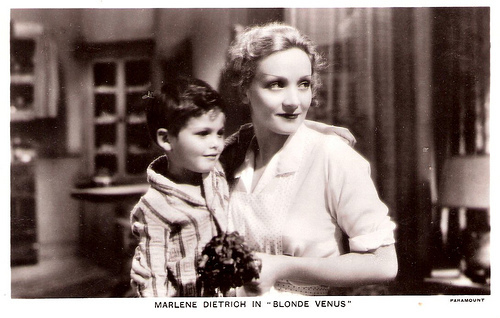
British postcard, distributed in the Netherlands by M. Bonnist & Zonen, Amsterdam, no. 136e. Photo: Paramount. Publicity still for Blonde Venus (Josef von Sternberg, 1932) with Dickie Moore.
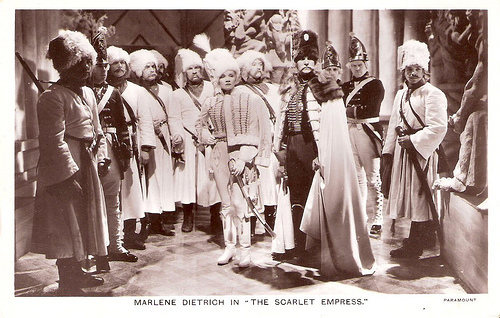
British-Dutch postcard by M. Bonnist & Zonen, Amsterdam, no. B 351. Photo: Paramount. Publicity still for The Scarlet Empress (Josef von Sternberg, 1934) with Marlene Dietrich as Catherine the Great, the notorious empress of Russia.
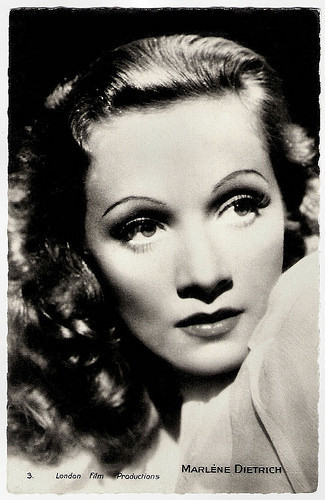
French postcard by Editions Chantal, Rueil, no. 3. Photo: London Film Productions. Publicity still for Knight Without Armour (Jacques Feyder, 1937).
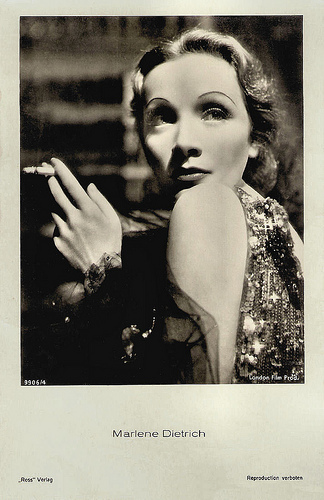
German postcard by Ross Verlag, no. 9906/4, 1935-1936. Photo: London Film Productions. Marlene Dietrich in the film Knight Without Armour (Jacques Feyder, 1937).
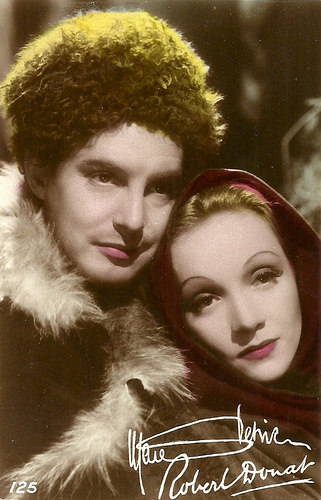
British postcard by Art Photo Postcard, no. 125. Marlene Dietrich and Robert Donat in the London Films production Knight Without Armour (Jacques Feyder, 1937).
Body-hugging Dresses and careful stage lighting
From the early 1950s until the mid-1970s, Marlene Dietrich worked almost exclusively as a highly-paid cabaret artist, performing live in large theatres in major cities worldwide. Her costumes (body-hugging dresses covered with thousands of crystals as well as a swansdown coat), body-sculpting undergarments, careful stage lighting helped to preserve Dietrich's glamorous image well into old age.
She never fully regained her former screen glory, but she continued performing in films for distinguished directors. Her successful film roles included an exotic gypsy in Golden Earrings (Mitchell Leisen, 1947), with Ray Milland , an ex-Nazi cafe singer in A Foreign Affair (Billy Wilder, 1948), a famous singer and murderer in Stage Fright (Alfred Hitchcock, 1950), an aging bandit queen in Rancho Notorious (Fritz Lang, 1952), the wife of a suspected murderer in Witness for the Prosecution (Billy Wilder, 1957), a cynical brothel-keeper in Touch of Evil (Orson Welles, 1958), and the aristocratic widow of a prominent Nazi general in Judgment at Nuremberg (Stanley Kramer, 1961).
Dietrich's show business career largely ended in 1975, when she broke her leg during a stage performance in Sydney, Australia. Her husband, Rudolf Sieber, died of cancer in 1976. Her final on-camera film appearance was a small role in Schöner Gigolo, armer Gigolo/Just a Gigolo (David Hemmings, 1979), starring David Bowie .
Dietrich withdrew to her apartment in Paris. She spent the final 11 years of her life mostly bedridden, allowing only a select few — including family and employees — to enter the apartment. During this time, she was a prolific letter-writer and phone-caller. Her autobiography, Nehmt nur mein Leben/Marlene, was published in 1979.
In 1982, she agreed to participate in a documentary film about her life, Marlene (1984), but refused to be filmed. The film's director, Maximilian Schell, was only allowed to record her voice. He used his interviews with her as the basis for the film, set to a collage of film clips from her career. The final film won several European film prizes and received an Academy Award nomination for Best Documentary in 1984. Newsweek named it "a unique film, perhaps the most fascinating and affecting documentary ever made about a great movie star".
In 1992, Marlene Dietrich died of renal failure at the age of 90 in Paris. Ten years after her death, Berlin - the city of Dietrich's birth which she shunned for most of her life - declared her an honorary citizen.
In a 1992 obituary The New York Times wrote: "In her films and record-breaking cabaret performances, Miss Dietrich artfully projected cool sophistication, self-mockery and infinite experience. Her sexuality was audacious, her wit was insolent and her manner was ageless. With a world-weary charm and a diaphanous gown showing off her celebrated legs, she was the quintessential cabaret entertainer of Weimar-era Germany."
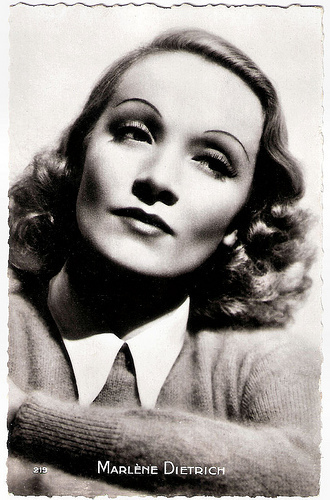
French postcard by Editions P.I., no. 219.
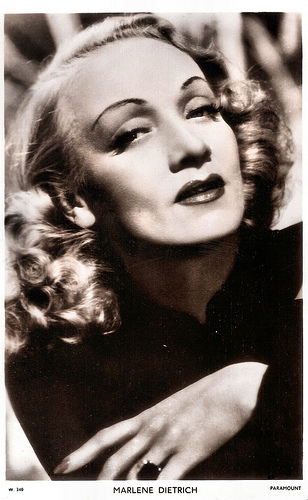
British postcard in the Picturegoer series, London, no. W 340. Photo: Paramount.
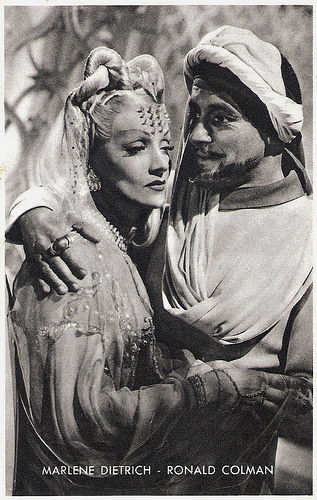
Belgian collectors card by Kwatta, Bois d'Haine, no. C 156. Photo: M.G.M. Publicity still for Kismet (William Dieterle, 1944) with Ronald Colman .
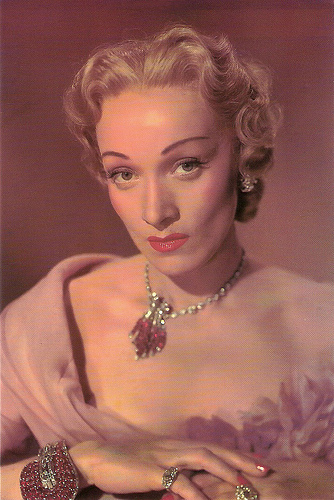
American postcard by Quantity Postcards, Oakland, no. 3372.
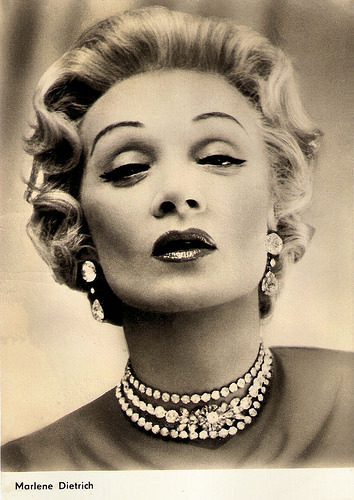
East-German postcard by VEB Progress Filmvertrieb, no. 2.192, 1964.
Marlene Dietrich sings Falling in love again in the English version of Der blaue Engel/The Blue Angel (Josef von Sternberg, 1930). Source: EdmundusRex (YouTube).
Sources: James Naremore (Senses of Cinema), Wikipedia, The New York Times, Marlene Dietrich Collection Berlin, and .

German postcard by Ross Verlag, no. 5582/1, 1930-1931. Photo: Paramount.

French postcard by Europe, no. 2060. Photo: Paramount. Publicity still for Shanghai Express (Josef von Sternberg, 1932).

French postcard by Editions P.I., presented by NV Victoria, Brussels, no. 219. Photo: Universal International.

German postcard by Ross Verlag, no. 501. Photo: Paramount. Publicity still for Morocco (Josef von Sternberg, 1930).

German postcard by Ross Verlag, no. 545. Photo: Paramount.
Chorus Girl
Marie Magdalene Dietrich was born in Berlin-Schöneberg, Germany, in 1901. She was the younger of two daughters of Louis Erich Otto Dietrich and Wilhelmina Elisabeth Josephine née Felsing.
Her mother was from a well-to-do Berlin family who owned a clock making firm and her father was a police lieutenant. He died in 1911. His best friend, Eduard von Losch, an aristocrat first lieutenant in the Grenadiers courted Wilhelmina and eventually married her in 1916. He was killed on the Russian front in 1918.
The young Marie Magdalene and her elder sister, Elisabeth, were brought up strictly in an upper-middle-class Prussian home. It would be this influence which would shape her acting career and her life as a citizen in years to come.
Dietrich attended school in Berlin and Dessau from 1907 to 1919. She studied violin and became interested in theatre and poetry as a teenager. Her dreams of becoming a concert violinist were cut short when she injured her wrist.
In 1921, she auditioned unsuccessfully for Max Reinhardt's drama academy, but she soon found herself working in his theatres as a chorus girl and playing small roles in dramas.
The next year she played a part in the silent film So sind die Männer/The Little Napoleon (Georg Jacoby, 1922). On the set of another film, Tragödie der Liebe/The Tragedy of Love (Joe May, 1923), she met production assistant Rudolf Sieber. They were married in 1923. Her only child, daughter Maria Elisabeth Sieber, later billed as actress Maria Riva, was born in 1924.
Throughout the 1920s Marlene continued to work on stage and in films both in Berlin and Vienna. She attracted most attention in stage musicals and revues, such as Broadway and Es Liegt in der Luft/It's in the Air.
By the late 1920s, she was also playing leading parts in such films as Café Elektric/Cafe Electric (Gustav Ucicky, 1927) with Willi Forst , Ich küsse Ihre Hand, Madame/I Kiss Your Hand Madame (Robert Land, 1929) with Harry Liedtke , and Die Frau, nach der man sich sehnt/The Woman One Longs For (Kurt/Curtis Bernhardt, 1929) opposite Fritz Kortner .

German postcard by Ross Verlag, no. 6673/2, 1931-1932. Photo: Don English / Paramount. Publicity still for Shanghai Express (Josef von Sternberg, 1932).

German postcard by Ross Verlag, no. 5968/1, 1930-1931. Photo: Paramount. Marlene Dietrich in the film The Song of Songs (Rouben Mamoulian, 1933).

German postcard by Ross Verlag, no. 7789/2, 1932-1933. Photo: Paramount. Marlene Dietrich in the film The Song of Songs (Rouben Mamoulian, 1933).

German postcard by Ross Verlag, no. 8709/1, 1933-1934. Photo: Paramount. Publicity still for The Scarlet Empress (Josef von Sternberg, 1934) with Gavin Gordon.

German postcard by Ross Verlag, no. 8995/1, 1933-1934. Photo: Paramount. Publicity still for The Devil Is a Woman (Josef von Sternberg, 1935).
Lola-Lola
In 1929 Marlene Dietrich played her breakthrough role of Lola-Lola, a cabaret singer who causes the downfall of Immanuel Rath ( Emil Jannings ), a hitherto respected schoolmaster, in the Ufa production Der blaue Engel/The Blue Angel (Josef von Sternberg, 1930).
Josef von Sternberg thereafter took credit for having ‘discovered’ her. The film is also noteworthy for introducing her signature song Falling in Love Again. On the strength of Der blaue Engel's success, and with encouragement and promotion from Von Sternberg, Dietrich then moved to Hollywood. She left her husband and daughter behind.
Paramount sought to market her as a German answer to MGM's Swedish sensation Greta Garbo . Her first American film, Morocco (Josef von Sternberg, 1930) opposite Gary Cooper earned her her only Oscar nomination.
Between 1930 and 1935 she was the star of six films directed by von Sternberg at Paramount: Morocco (1930); Dishonored (1931), about a spy who betrays her country for love of a worthless man ( Victor McLaglen ); Shanghai Express (1932), a melodrama in which she is a China Coast prostitute who offers herself to a warlord (Warner Oland) to save the life of a former lover ( Clive Brook ); Blonde Venus (1932), a mother-love soap opera;, The Scarlet Empress (1934), an opulent and visually stunning melodrama about a lascivious Catherine the Great; and The Devil Is A Woman (1935), an erotic tale about a soldier-corrupting vamp in turn-of-the-century Seville.
Wikipedia describes how Von Sternberg worked very effectively with Dietrich to create the image of a glamorous femme fatale: "He encouraged her to lose weight and coached her intensively as an actress – she, in turn, was willing to trust him and follow his sometimes imperious direction in a way that a number of other performers resisted. A crucial part of the overall effect was created by Von Sternberg's exceptional skill in lighting and photographing Dietrich to optimum effect — the use of light and shadow, including the impact of light passed through a veil or slatted blinds (as for example in Shanghai Express) — which, when combined with scrupulous attention to all aspects of set design and costumes, make this series of films among the most visually stylish in cinema history."
Because it displayed her beauty most effectively, The Devil Is a Woman was her particular favourite. But after the dismal failure of The Devil Is A Woman, Paramount fired Von Sternberg, and the star and director would never work together again.

French postcard by EDUG, no. 1073. Photo: Paramount. Publicity still for Blonde Venus (Josef von Sternberg, 1932).

French postcard by Europe, no. 58. Photo: Paramount. Publicity still for Shanghai Express (Josef von Sternberg, 1932).

Dutch postcard, no. 294. Photo: Paramount.

Dutch postcard, no. 326. Sent by mail in the Netherlands in 1934. Photo: Paramount. Publicity still for Shanghai Express (Josef von Sternberg, 1932).

British postcard by Film-Kurier Series, London, no. 19. Photo: Paramount Pictures. Publicity still for The Scarlet Empress (Josef von Sternberg, 1934).
Box Office Poison
Without Von Sternberg, Marlene Dietrich made her first comedy, Desire (Frank Borzage, 1936). It was a satire about an urbane jewel thief (Dietrich) who steals a choice necklace from a Parisian jeweller and, in efforts to keep it, becomes involved with a hayseed Detroit engineer (Gary Cooper).
Although Dietrich's salary in the mid 1930s was enormous, she was never listed among the top ten box-office attractions, and depression-era audiences often felt she was preposterously exotic. She was even labelled 'box office poison' after Knight Without Armour (Jacques Feyder, 1937) proved an expensive flop.
In 1939, her stardom revived when she played the freewheeling saloon entertainer Frenchie in the comic Western Destry Rides Again (George Marshall, 1939) opposite James Stewart. Hollywood's attempt to make her more 'ordinary' worked. The film also introduced another favourite song, The Boys in the Back Room.
She played a similar role with John Wayne in The Spoilers (Ray Enright, 1942).
In December 1941, the US had entered World War II, and Dietrich became one of the first celebrities to raise war bonds. She toured the US from January 1942 to September 1943 and it is said that she sold more war bonds than any other star. During two extended tours for the USO in 1944 and 1945, she sang and performed the singing saw for Allied troops on the front lines in Algeria, Italy, England and France.
For musical propaganda broadcasts designed to demoralize enemy soldiers, she recorded a number of songs in German, including the ballad Lili Marleen. The troops loved her.
In 1947, she was awarded the Presidential Medal of Freedom by the US for her wartime work. In 1950, the French state conferred the title of Chevalier de la Légion d' Honneur (knight of the Legion of Honour) on her, in 1971 she was named Officier by President Pompidou and in 1989 Commandeur by President Mitterrand.

British postcard, distributed in the Netherlands by M. Bonnist & Zonen, Amsterdam, no. 136e. Photo: Paramount. Publicity still for Blonde Venus (Josef von Sternberg, 1932) with Dickie Moore.

British-Dutch postcard by M. Bonnist & Zonen, Amsterdam, no. B 351. Photo: Paramount. Publicity still for The Scarlet Empress (Josef von Sternberg, 1934) with Marlene Dietrich as Catherine the Great, the notorious empress of Russia.

French postcard by Editions Chantal, Rueil, no. 3. Photo: London Film Productions. Publicity still for Knight Without Armour (Jacques Feyder, 1937).

German postcard by Ross Verlag, no. 9906/4, 1935-1936. Photo: London Film Productions. Marlene Dietrich in the film Knight Without Armour (Jacques Feyder, 1937).

British postcard by Art Photo Postcard, no. 125. Marlene Dietrich and Robert Donat in the London Films production Knight Without Armour (Jacques Feyder, 1937).
Body-hugging Dresses and careful stage lighting
From the early 1950s until the mid-1970s, Marlene Dietrich worked almost exclusively as a highly-paid cabaret artist, performing live in large theatres in major cities worldwide. Her costumes (body-hugging dresses covered with thousands of crystals as well as a swansdown coat), body-sculpting undergarments, careful stage lighting helped to preserve Dietrich's glamorous image well into old age.
She never fully regained her former screen glory, but she continued performing in films for distinguished directors. Her successful film roles included an exotic gypsy in Golden Earrings (Mitchell Leisen, 1947), with Ray Milland , an ex-Nazi cafe singer in A Foreign Affair (Billy Wilder, 1948), a famous singer and murderer in Stage Fright (Alfred Hitchcock, 1950), an aging bandit queen in Rancho Notorious (Fritz Lang, 1952), the wife of a suspected murderer in Witness for the Prosecution (Billy Wilder, 1957), a cynical brothel-keeper in Touch of Evil (Orson Welles, 1958), and the aristocratic widow of a prominent Nazi general in Judgment at Nuremberg (Stanley Kramer, 1961).
Dietrich's show business career largely ended in 1975, when she broke her leg during a stage performance in Sydney, Australia. Her husband, Rudolf Sieber, died of cancer in 1976. Her final on-camera film appearance was a small role in Schöner Gigolo, armer Gigolo/Just a Gigolo (David Hemmings, 1979), starring David Bowie .
Dietrich withdrew to her apartment in Paris. She spent the final 11 years of her life mostly bedridden, allowing only a select few — including family and employees — to enter the apartment. During this time, she was a prolific letter-writer and phone-caller. Her autobiography, Nehmt nur mein Leben/Marlene, was published in 1979.
In 1982, she agreed to participate in a documentary film about her life, Marlene (1984), but refused to be filmed. The film's director, Maximilian Schell, was only allowed to record her voice. He used his interviews with her as the basis for the film, set to a collage of film clips from her career. The final film won several European film prizes and received an Academy Award nomination for Best Documentary in 1984. Newsweek named it "a unique film, perhaps the most fascinating and affecting documentary ever made about a great movie star".
In 1992, Marlene Dietrich died of renal failure at the age of 90 in Paris. Ten years after her death, Berlin - the city of Dietrich's birth which she shunned for most of her life - declared her an honorary citizen.
In a 1992 obituary The New York Times wrote: "In her films and record-breaking cabaret performances, Miss Dietrich artfully projected cool sophistication, self-mockery and infinite experience. Her sexuality was audacious, her wit was insolent and her manner was ageless. With a world-weary charm and a diaphanous gown showing off her celebrated legs, she was the quintessential cabaret entertainer of Weimar-era Germany."

French postcard by Editions P.I., no. 219.

British postcard in the Picturegoer series, London, no. W 340. Photo: Paramount.

Belgian collectors card by Kwatta, Bois d'Haine, no. C 156. Photo: M.G.M. Publicity still for Kismet (William Dieterle, 1944) with Ronald Colman .

American postcard by Quantity Postcards, Oakland, no. 3372.

East-German postcard by VEB Progress Filmvertrieb, no. 2.192, 1964.
Marlene Dietrich sings Falling in love again in the English version of Der blaue Engel/The Blue Angel (Josef von Sternberg, 1930). Source: EdmundusRex (YouTube).
Sources: James Naremore (Senses of Cinema), Wikipedia, The New York Times, Marlene Dietrich Collection Berlin, and .
Published on February 15, 2015 22:00
February 14, 2015
Luigi Serventi
Luigi Serventi (1885-1976) was a star of the Italian silent cinema, often cast opposite such divas as Pina Menichelli. After his Italian career he continued to appear in films in Germany and Czechoslovakia during the 1920s.
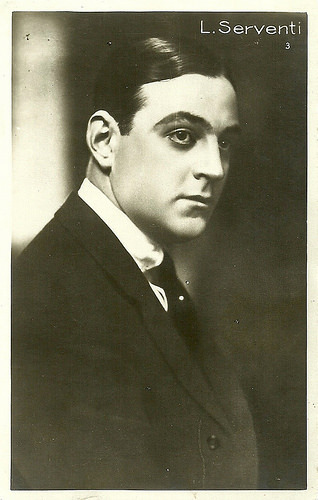
Italian postcard by Ed. Vettori, Bologna.
Specialized in romantic roles
Luigi Serventi aka Gigi Serventi was born in Rome in 1885. He came from a Roman bourgeois family.
He started his stage acting career in 1911, entering the theatre company of Vittoria Lepanto . Afterwards he moved over to the companies of Ermete Novelli and Ettore Berti.
In 1914 he abandoned the stage to fully dedicate himself to film acting, first as an extra at the Latium Film company. Later, he worked for other production companies, such as Pasquali, Cines, Milano, Itala, etc.
He was the male lead in successful films such as Il vetturale del Moncenisio/The Courier of Moncenisio (Leopoldo Carlucci, 1916) with Lina Millefleurs, Il Re, le Torri e gli Alfieri/The king, the Towers and the Ensigns (Ivo Illuminati, 1917), a rare, lost futurist film with Giorgina Dentice di Frasso, Il padrone delle ferriere/The owner of the ironworks (Eugenio Perego, 1919) with Amleto Novelli and Pina Menichelli , and Il romanzo di un giovane povero/The romance of a poor young man (1920) with again Menichelli.
Serventi confirmed himself as one the male stars of Italian cinema in the silent era. He specialized in romantic roles, and in a period of five years he acted together with many of the female stars of the Italian cinema.
With Mercedes Brignone , he co-starred in Vizio atavico/Ancestral vice (Baldassarre Negroni, 1914), La dote del burattinaio/The Puppet's Dowry (Baldassarre Negroni, 1914), Lo spettro bianco a Saint Moritz/The white specter in Saint Moritz (Alfredo Robert, 1914), and Mezzanotte/Midnight (Augusto Genina, 1915).
He also co-starred with Hesperia in Per la felicità degli altri/The Penalty of Beauty(Baldassarre Negroni, 1914) and Dopo il veglione/After the New Year's Eve (Augusto Genina, 1914), with Bianca Virginia Camagni in Non è tutto oro/It is not all gold (1914), with Gemma Stagno Belllincioni in Cavalleria rusticana (Ugo Falena, 1916) and with Leda Gys in La Bohème (Amleto Palermi, 1918).
Most famously Serventi co-starred with the diva Pina Menichelli . They acted together in two films directed by Augusto Genina, La parola che uccide/The word that kills (Augusto Genina, 1914) and Il mistero del castello di Monroe/The Munroe Manor Mystery (Augusto Genina, 1914), and later in five by Eugenio Perego and one by Amleto Palermi, the Octave Feuillet adaptation Il romanzo di un giovane povero/The romance of a poor young man (1920).
In 1914-1915 Augusto Genina directed Serventi in eight films and during the 1920s in two more. Other directors with whom Serventi frequently worked were Baldassarre Negroni (1914-1915), Ugo Falena (1916-1917) and Eugenio Perego (191-1920).
Occasionally, Serventi tried his luck with film direction. He co-directed with Lucio D’Ambra Le mogli e le arance/The wives and the oranges (1917), and solo he did Suprema bellezza/Supreme beauty (1921). In both films he also played the male lead.
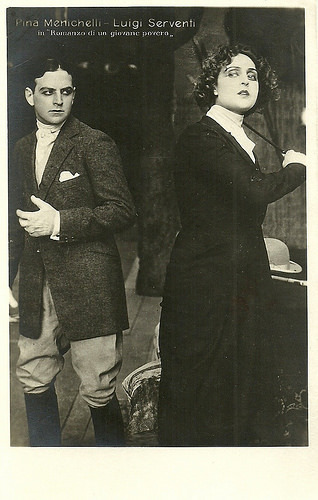
Italian postcard by Ed. Vettori Bolognam no. . Publicity still of Pina Menichelli and Luigi Serventi in Il romanzo di un giovane povero/The romance of a poor young man (1920). The proud Margherita (Menichelli), daughter of the rich Laroque, falls in love with her father's administrator, Massimo Odiot (Serventi), but she fears he is only after her money. The real vulture, however, is a corrupt count, to whom Margharita is betrothed, unknowing of the man's plans. When Massimo and Margherita are accidentally locked into an old tower, and she treats him cruelly, Massimo sacrifices himself and jumps from the tower, to get help. When afterwards he gets hold of a fortune, nothing can prevent anymore the marriage between the two.
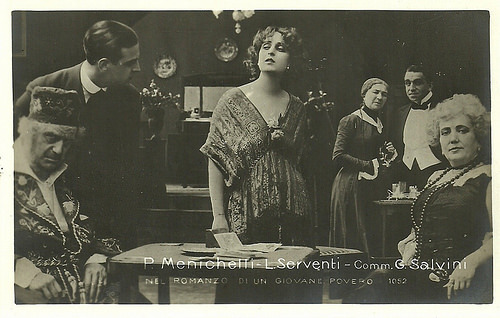
Italian postcard by Ed. Vettori Bologna, no. 1052. Publicity still of Pina Menichelli and Luigi Serventi in Il romanzo di un giovane povero/The romance of a poor young man (1920).
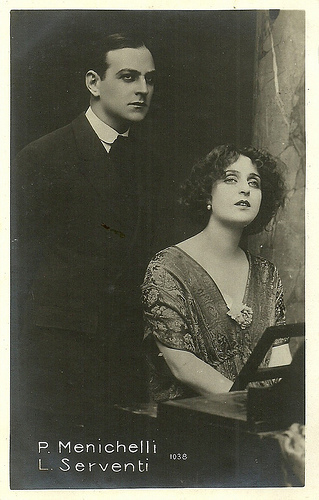
Italian postcard by Ed. Vettori Bologna, no. 1038. Publicity still of Pina Menichelli and Luigi Serventi in Il romanzo di un giovane povero/The romance of a poor young man (1920).
German aristocrats
Because of the crisis in the Italian film industry, Luigi Serventi emigrated to Germany in 1922.
In Berlin he met the same public acclaim, when he appeared in several films, opposite female stars emigrated to Berlin like him, such as Lucy Doraine , Maria Jacobini and Diana Karenne .
His first German film was Sterbende Volker/Dying people (Robert Reinert, 1922), which had an all-star cast that included Fritz Kortner , Helena Makowska , Aud Egede Nissen , Otto Gebühr , Gustavo Serena and Paul Wegener .
In Germany, he often played aristocrats, as in Bohème - Künstlerliebe/Bohème - artists love (Gennaro Righelli, 1923), Der Geldteufel/The Money Devil (Heinz Goldberg, 1923), Finale der Liebe/Finale of Love (Felix Basch, 1925), and Die Ausgestoßenen/Caught in Berlin's Underworld (Martin Berger, 1927).
Serventi also acted in Czechoslovakia in the films Muz bez srdce/The Man Without a Heart (1923) and Vyznavaci slunce/The Sun Disciples (Václav Binovec, 1926), and Erotikon/Seduction (Gustav Machatý, 1929) starring Ita Rina . In Austria he starred in Lebende Ware/Living goods (Robert Wohlmuth, 1929).
Yet, Serventi was also called back to Italy to act in films such as Voglio tradire mio marito/I Want to Betray My Husband (Mario Camerini, 1925) with Linda Pini and Alberto Collo , Il gigante delle Dolomiti/The Giant of the Dolomites (Guido Brignone, 1927) with Bartolomeo Pagano in his final Maciste film, and Il cantastorie di Venezia/The Storyteller of Venice (Atto Retti-Marsani, 1929).
When sound cinema set in, Serventi’s career started to fade way. His last true film part was in Berge in Flammen/Mountains on Fire (Luis Trenker, Karl Hartl, 1931) with Luis Trenker and Lissi Arna . One of the series of popular Mountain films of the era, it was shot on location in the Dolomites.
In the same year Serventi settled in Kitzbühel, Austria, and remained there for many years. Only at a very high age he returned to Italy.
Luigi Serventi died in Rome, in 1976.
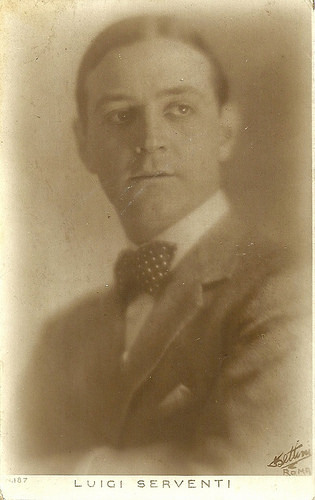
Italian postcard by Ed. Soc. Anon. It. 'Bettini', Roma , no. 187. Photo: Bettini, Roma.
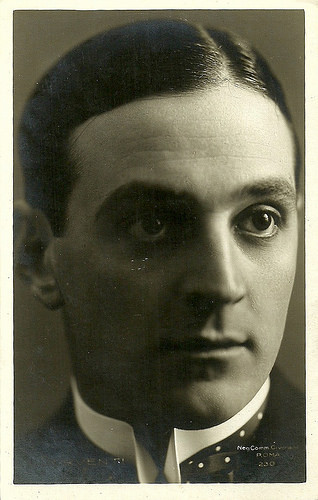
Italian postcard by Ed. Vettori, Bologna, no. 220. Photo: Civirani, Roma.
Sources: Wikipedia (English and Italian) and.

Italian postcard by Ed. Vettori, Bologna.
Specialized in romantic roles
Luigi Serventi aka Gigi Serventi was born in Rome in 1885. He came from a Roman bourgeois family.
He started his stage acting career in 1911, entering the theatre company of Vittoria Lepanto . Afterwards he moved over to the companies of Ermete Novelli and Ettore Berti.
In 1914 he abandoned the stage to fully dedicate himself to film acting, first as an extra at the Latium Film company. Later, he worked for other production companies, such as Pasquali, Cines, Milano, Itala, etc.
He was the male lead in successful films such as Il vetturale del Moncenisio/The Courier of Moncenisio (Leopoldo Carlucci, 1916) with Lina Millefleurs, Il Re, le Torri e gli Alfieri/The king, the Towers and the Ensigns (Ivo Illuminati, 1917), a rare, lost futurist film with Giorgina Dentice di Frasso, Il padrone delle ferriere/The owner of the ironworks (Eugenio Perego, 1919) with Amleto Novelli and Pina Menichelli , and Il romanzo di un giovane povero/The romance of a poor young man (1920) with again Menichelli.
Serventi confirmed himself as one the male stars of Italian cinema in the silent era. He specialized in romantic roles, and in a period of five years he acted together with many of the female stars of the Italian cinema.
With Mercedes Brignone , he co-starred in Vizio atavico/Ancestral vice (Baldassarre Negroni, 1914), La dote del burattinaio/The Puppet's Dowry (Baldassarre Negroni, 1914), Lo spettro bianco a Saint Moritz/The white specter in Saint Moritz (Alfredo Robert, 1914), and Mezzanotte/Midnight (Augusto Genina, 1915).
He also co-starred with Hesperia in Per la felicità degli altri/The Penalty of Beauty(Baldassarre Negroni, 1914) and Dopo il veglione/After the New Year's Eve (Augusto Genina, 1914), with Bianca Virginia Camagni in Non è tutto oro/It is not all gold (1914), with Gemma Stagno Belllincioni in Cavalleria rusticana (Ugo Falena, 1916) and with Leda Gys in La Bohème (Amleto Palermi, 1918).
Most famously Serventi co-starred with the diva Pina Menichelli . They acted together in two films directed by Augusto Genina, La parola che uccide/The word that kills (Augusto Genina, 1914) and Il mistero del castello di Monroe/The Munroe Manor Mystery (Augusto Genina, 1914), and later in five by Eugenio Perego and one by Amleto Palermi, the Octave Feuillet adaptation Il romanzo di un giovane povero/The romance of a poor young man (1920).
In 1914-1915 Augusto Genina directed Serventi in eight films and during the 1920s in two more. Other directors with whom Serventi frequently worked were Baldassarre Negroni (1914-1915), Ugo Falena (1916-1917) and Eugenio Perego (191-1920).
Occasionally, Serventi tried his luck with film direction. He co-directed with Lucio D’Ambra Le mogli e le arance/The wives and the oranges (1917), and solo he did Suprema bellezza/Supreme beauty (1921). In both films he also played the male lead.

Italian postcard by Ed. Vettori Bolognam no. . Publicity still of Pina Menichelli and Luigi Serventi in Il romanzo di un giovane povero/The romance of a poor young man (1920). The proud Margherita (Menichelli), daughter of the rich Laroque, falls in love with her father's administrator, Massimo Odiot (Serventi), but she fears he is only after her money. The real vulture, however, is a corrupt count, to whom Margharita is betrothed, unknowing of the man's plans. When Massimo and Margherita are accidentally locked into an old tower, and she treats him cruelly, Massimo sacrifices himself and jumps from the tower, to get help. When afterwards he gets hold of a fortune, nothing can prevent anymore the marriage between the two.

Italian postcard by Ed. Vettori Bologna, no. 1052. Publicity still of Pina Menichelli and Luigi Serventi in Il romanzo di un giovane povero/The romance of a poor young man (1920).

Italian postcard by Ed. Vettori Bologna, no. 1038. Publicity still of Pina Menichelli and Luigi Serventi in Il romanzo di un giovane povero/The romance of a poor young man (1920).
German aristocrats
Because of the crisis in the Italian film industry, Luigi Serventi emigrated to Germany in 1922.
In Berlin he met the same public acclaim, when he appeared in several films, opposite female stars emigrated to Berlin like him, such as Lucy Doraine , Maria Jacobini and Diana Karenne .
His first German film was Sterbende Volker/Dying people (Robert Reinert, 1922), which had an all-star cast that included Fritz Kortner , Helena Makowska , Aud Egede Nissen , Otto Gebühr , Gustavo Serena and Paul Wegener .
In Germany, he often played aristocrats, as in Bohème - Künstlerliebe/Bohème - artists love (Gennaro Righelli, 1923), Der Geldteufel/The Money Devil (Heinz Goldberg, 1923), Finale der Liebe/Finale of Love (Felix Basch, 1925), and Die Ausgestoßenen/Caught in Berlin's Underworld (Martin Berger, 1927).
Serventi also acted in Czechoslovakia in the films Muz bez srdce/The Man Without a Heart (1923) and Vyznavaci slunce/The Sun Disciples (Václav Binovec, 1926), and Erotikon/Seduction (Gustav Machatý, 1929) starring Ita Rina . In Austria he starred in Lebende Ware/Living goods (Robert Wohlmuth, 1929).
Yet, Serventi was also called back to Italy to act in films such as Voglio tradire mio marito/I Want to Betray My Husband (Mario Camerini, 1925) with Linda Pini and Alberto Collo , Il gigante delle Dolomiti/The Giant of the Dolomites (Guido Brignone, 1927) with Bartolomeo Pagano in his final Maciste film, and Il cantastorie di Venezia/The Storyteller of Venice (Atto Retti-Marsani, 1929).
When sound cinema set in, Serventi’s career started to fade way. His last true film part was in Berge in Flammen/Mountains on Fire (Luis Trenker, Karl Hartl, 1931) with Luis Trenker and Lissi Arna . One of the series of popular Mountain films of the era, it was shot on location in the Dolomites.
In the same year Serventi settled in Kitzbühel, Austria, and remained there for many years. Only at a very high age he returned to Italy.
Luigi Serventi died in Rome, in 1976.

Italian postcard by Ed. Soc. Anon. It. 'Bettini', Roma , no. 187. Photo: Bettini, Roma.

Italian postcard by Ed. Vettori, Bologna, no. 220. Photo: Civirani, Roma.
Sources: Wikipedia (English and Italian) and.
Published on February 14, 2015 22:00
February 13, 2015
Die Puppe (1919)
The German silent film Die Puppe/The Doll (1919) is a charming romantic fantasy directed by Ernst Lubitsch. The splendidly original film is loosely based on the short story by E.T.A. Hoffmann, which also inspired the ballet Coppélia.
German postcard by Ross Verlag, Berlin, no. 635/4 1919-1924. Photo: Union. Publicity still for Die Puppe/The Doll (Ernst Lubitsch, 1919) with Ossi Oswalda and Hermann Thimig .
A special service for bachelors, widowers and misogynists
In the opening shot of Die Puppe/The Doll, Ernst Lubitsch sets up a doll's house against a stylised backdrop. A close-up of this model then dissolves into a full-sized version of the same stylised setting, from which emerge actors dressed as dolls. From this point onward, the entire film is staged on highly stylised sets.
The old Baron von Chanterelle (Max Kronert) has no family except for his gormless nephew Lancelot ( Hermann Thimig ). He wants to preserve his family line, so he forces Lancelot to choose one of the village maidens to wed.
Lancelot flees to a monastery to escape the forty eager maidens. The Baron offers his nephew a dowry of 300,000 francs to get married. But Lancelot is afraid of women.
The prior (Jacob Tiedtke) shows him an advertisement from the doll-maker Hilarius (Victor Janson), who offers a special service 'for bachelors, widowers and misogynists': a life-size clockwork girl! Lancelot decides to marry the mechanical bride, collect the dowry, then stash the doll in the attic.
Hilarius has just finished making a replica of his pretty daughter Ossi ( Ossi Oswalda ). The clockwork girl has a control panel on her back and a crank to wind her up.
The doll-maker's young apprentice (Gerhard Ritterband) accidentally breaks the arm of the doll and convinces the real Ossi to mimic the doll. Lancelot buys her, thinking she is a doll, and takes her back to the monastery, where they are wed.
Ernst Lubitsch and Ossi Oswalda . German postcard by Ross Verlag, Berlin, no. 337/1, 1919-1924. Photo: Zander & Labisch.
An extremely kinky performance
Ernst Lubitsch once wrote to his biographer Herman G. Weinberg that he considered Die Puppe and Die Austernprinzessin/The Oyster Princess (1919) as his most outstanding comedies produced in Germany before he departed for Hollywood to make Rosita (1923).
Die Puppe/The Doll features, according to F Gwynplaine MacIntyre at IMDb , 'an extremely kinky performance' by Ossi Oswalda : "In a frilly outfit with a short skirt, Ossi is very pretty as both the mechanical girl and the real one. There is some surprisingly good double-exposure in a couple of camera set-ups when the real Ossi and the mechanical one are onscreen simultaneously. Brilliant camerawork throughout by the great Theodor Sparkuhl."
The great charm of Die Puppe is its mood of fairy-tale unreality. The coachman's horses are played by men in pantomime-horse costumes. A cat and a rooster are played by cut-out figures. The moon has a human face.
F Gwynplaine MacIntyre at IMDb : "I enjoyed a bizarre scene in which an entire roomful of mechanical girls dance for Lancelot. The sequences of Ossi (the real one) dancing stiffly while pretending to be a clockwork girl remind me of the sequence in Metropolis when the female robot takes her first awkward steps. The Doll is an absolute delight from beginning to end, a film that the entire family will enjoy."
German postcard by Ross Verlag, Berlin, no. 635/5 1919-1924. Photo: Union. Publicity still for Die Puppe/The Doll (Ernst Lubitsch, 1919) with Ossi Oswalda and Hermann Thimig .
Sources: F Gwynplaine MacIntyre (IMDb), Will Gilbert (IMDb), Wikipedia and IMDb.
German postcard by Ross Verlag, Berlin, no. 635/4 1919-1924. Photo: Union. Publicity still for Die Puppe/The Doll (Ernst Lubitsch, 1919) with Ossi Oswalda and Hermann Thimig .
A special service for bachelors, widowers and misogynists
In the opening shot of Die Puppe/The Doll, Ernst Lubitsch sets up a doll's house against a stylised backdrop. A close-up of this model then dissolves into a full-sized version of the same stylised setting, from which emerge actors dressed as dolls. From this point onward, the entire film is staged on highly stylised sets.
The old Baron von Chanterelle (Max Kronert) has no family except for his gormless nephew Lancelot ( Hermann Thimig ). He wants to preserve his family line, so he forces Lancelot to choose one of the village maidens to wed.
Lancelot flees to a monastery to escape the forty eager maidens. The Baron offers his nephew a dowry of 300,000 francs to get married. But Lancelot is afraid of women.
The prior (Jacob Tiedtke) shows him an advertisement from the doll-maker Hilarius (Victor Janson), who offers a special service 'for bachelors, widowers and misogynists': a life-size clockwork girl! Lancelot decides to marry the mechanical bride, collect the dowry, then stash the doll in the attic.
Hilarius has just finished making a replica of his pretty daughter Ossi ( Ossi Oswalda ). The clockwork girl has a control panel on her back and a crank to wind her up.
The doll-maker's young apprentice (Gerhard Ritterband) accidentally breaks the arm of the doll and convinces the real Ossi to mimic the doll. Lancelot buys her, thinking she is a doll, and takes her back to the monastery, where they are wed.
Ernst Lubitsch and Ossi Oswalda . German postcard by Ross Verlag, Berlin, no. 337/1, 1919-1924. Photo: Zander & Labisch.
An extremely kinky performance
Ernst Lubitsch once wrote to his biographer Herman G. Weinberg that he considered Die Puppe and Die Austernprinzessin/The Oyster Princess (1919) as his most outstanding comedies produced in Germany before he departed for Hollywood to make Rosita (1923).
Die Puppe/The Doll features, according to F Gwynplaine MacIntyre at IMDb , 'an extremely kinky performance' by Ossi Oswalda : "In a frilly outfit with a short skirt, Ossi is very pretty as both the mechanical girl and the real one. There is some surprisingly good double-exposure in a couple of camera set-ups when the real Ossi and the mechanical one are onscreen simultaneously. Brilliant camerawork throughout by the great Theodor Sparkuhl."
The great charm of Die Puppe is its mood of fairy-tale unreality. The coachman's horses are played by men in pantomime-horse costumes. A cat and a rooster are played by cut-out figures. The moon has a human face.
F Gwynplaine MacIntyre at IMDb : "I enjoyed a bizarre scene in which an entire roomful of mechanical girls dance for Lancelot. The sequences of Ossi (the real one) dancing stiffly while pretending to be a clockwork girl remind me of the sequence in Metropolis when the female robot takes her first awkward steps. The Doll is an absolute delight from beginning to end, a film that the entire family will enjoy."
German postcard by Ross Verlag, Berlin, no. 635/5 1919-1924. Photo: Union. Publicity still for Die Puppe/The Doll (Ernst Lubitsch, 1919) with Ossi Oswalda and Hermann Thimig .
Sources: F Gwynplaine MacIntyre (IMDb), Will Gilbert (IMDb), Wikipedia and IMDb.
Published on February 13, 2015 22:00
February 12, 2015
Josette Day
French film actress Josette Day (1914-1978) is best known as Belle in Jran Cocteau's unforgettable classic La belle et la bête/Beauty and the Beast (1946). She started her film career as a child and played during the 1930s and 1940s many leading parts in French films. In 1950 she ended her successful acting career, when she was only 36.
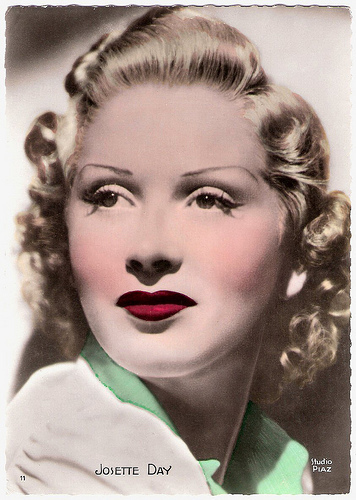
French postcard by Editions P.I., Paris, no. 11. Photo: Studio Piaz.
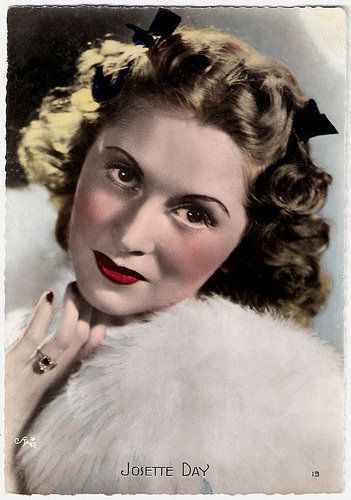
French postcard by Editions O.P., Paris, no. 15. Photo: Star.
Seven Films in a Year
Josette Day was born as Josette Noëlle Andrée Claire Dagory in Paris, in 1914.
At the age of five, she began her film career in Ames d'orient/Souls of the Orient (Léon Poirier, 1919). Till 1922 she made three films under her real name, Josette Dagory.
She also performed as a dancer, including a stint in the Paris Opera. An injury curtailed her career in dance when she was only 9 years old.
She did not return to the screen until she was an adult but then her film career soon took off. The sound film was recently introduced. As Josette Dagory she played the female lead in Serments/Oaths (Henri Fescourt, 1931) and Un bouquet de flirts/A bouquet of flirtations (Charles de Rochefort, 1931).
Then she changed her name to ‘Day’. Throughout the thirties she made numerous films, sometimes as many as seven in a year. Among her early sound films were the romantic comedy Allo Berlin? Ici Paris/Here's Berlin (Julien Duvivier, 1932), Coralie et Cie/Coralie and Company (Alberto Cavalcanti, 1933) starring Francoise Rosay , and Die Abenteuer des Königs Pausole/The Merry Monarch (Alexis Granowsky, 1933).
Die Abenteuer des Königs Pausole/The Merry Monarch was a Tobis production, that was made in a German, a French and an English version. In all three alternate language versions she was the leading lady opposite the famous Emil Jannings .
Later films were Les filles de la concierge/The Daughters of the Caretaker (Jacques Tourneur, 1934), Lucrèce Borgia/Lucrezia Borgia (Abel Gance, 1935) starring Edwige Feuillère , Ménilmontant (René Guissart, 1936), and L'homme du jour/The Man of the Hour (Julien Duvivier, 1937).
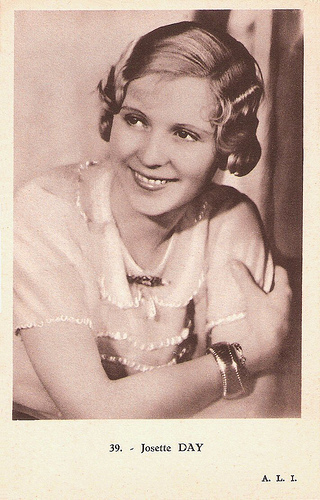
French (?) postcard by A.L.I., no. 39.
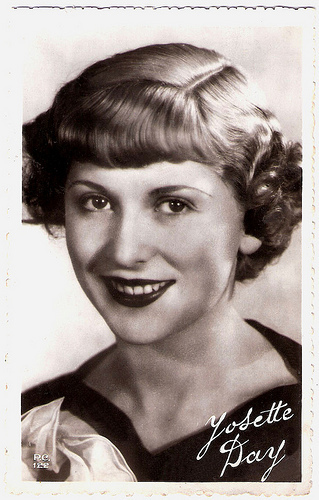
French postcard, no. PC 122.
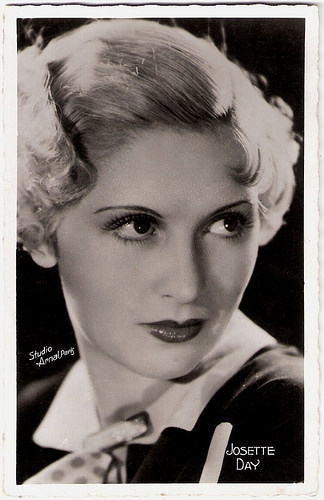
French postcard by Editions et Publications Cinematographiques. Photo: Studio Arnal, Paris.
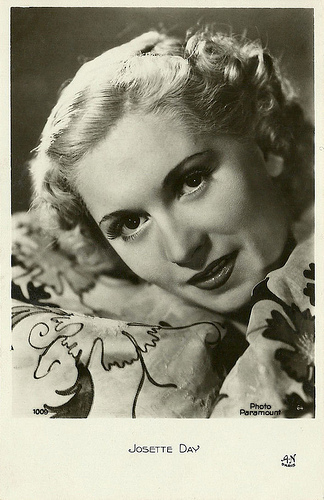
French postcard by A.N., Paris, no. 1009. Photo: Paramount. Collection: Didier Hanson.
Classic French Fairytale
In 1939, Josette Day met Marcel Pagnol and they had an affair. Pagnol was a famous French author, producer and director who owned his own film studio. Some sources say they were married, but on 2 July 1978, the French news paper Le Monde ran a correction of its obit of the day before. The union of Josette Day and Marcel Pagnol "was never consecrated by a marriage."
Her first great role was as Patricia Amoretti in his production La Fille du puisatier/The Well-Diggers Daughter (Marcel Pagnol, 1940) with Raimu and Fernandel . The couple also made Monsieur Brotonneau/Mr. Brotonneau (Alexander Esway, 1939) starring Raimu , La prière aux étoiles/The Prayer to the Stars (Marcel Pagnol, 1941) and Arlette et l'amour/Arlette and Love (Robert Vernay, 1943).
Day left Pagnol in 1944. Most of her films seem forgotten through the passage of time, except for one film for which she will always be remembered in the history of French cinema.
In 1946, she played Belle in the classic French fairy-tale La belle et la bête/Beauty and the Beast (Jean Cocteau, René Clément, 1946) opposite Jean Marais as the Beast.
At French Film Site , James Travers reviews: “This is one of the most important films in the history of cinema. By pushing film technology to its creative limits and avoiding sentimentality, Jean Cocteau succeeds in creating a film that is both visually entrancing and emotionally rewarding, whilst re-telling a familiar tale in a fresh and innovative way. (…) Of course, Cocteau is well-served by some great acting talent, in the form of Jean Marais and Josette Day as the lead characters.”
Two years after La belle et la bête she also appeared opposite Marais in Cocteau’s Les parents terrible/The Terrible Parents (1948), and she also appeared in his lost film Coriolan (Jean Cocteau, 1950).
Other interesting films were La révoltée/Stolen Affections (Marcel L’Herbier, 1948) with Victor Francen , and Swiss Tour/Four Days Leave (Leopold Lindtberg, 1950) with Cornell Wilde and Simone Signoret .
She was only 36 years old when she suddenly ended her career. She retired to marry a wealthy Belgian businessman, Maurice Solvay, whom she had hidden from the Nazis during World War II. She was only seen once in another film, as herself in the comedy L'amour, Madame/Love, Madame (Gilles Grangier, 1952) with Arletty and François Périer .
The last years of her life she devoted herself to charitable work. In 1960 her husvand had died. Josette Day died in 1978 in Paris. She was 63.
But was she really dead? 17 years later, Micheline Weill, an American woman living in a Philadelphia row house begged to differ to differ. In the Philadelphia Inquirer , she proclaimed: "I Am Alive" in lilting French. True? The writer, Leonard W. Boasberg, ends his article thus: "One thing is certain, if anything is certain in this world: She is not lying. She truly believes herself to be Josette Day. Possibly, her friend Tom Brady says, she is just a sweet and charming but confused old woman. On the other hand, he adds, if it seems almost too good to be true that she is Josette Day, that doesn't mean it isn't true."
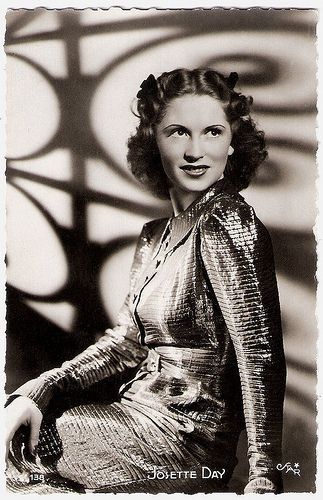
French postcard by Editions P.I., no. 138. Photo: Star.
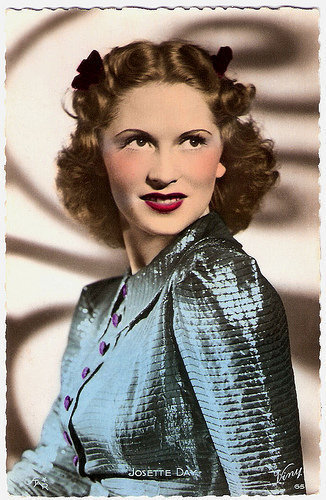
French postcard by Viny, no. 55. Photo: Star.
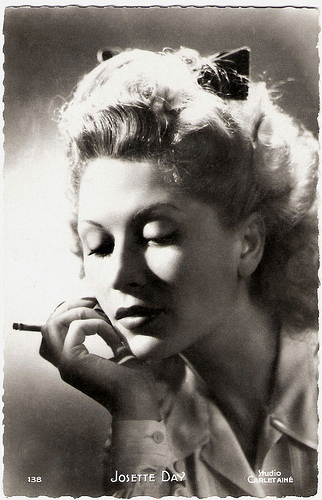
French postcard by Editions P.I., no. 138. Photo: Studio Carlet Ainé.
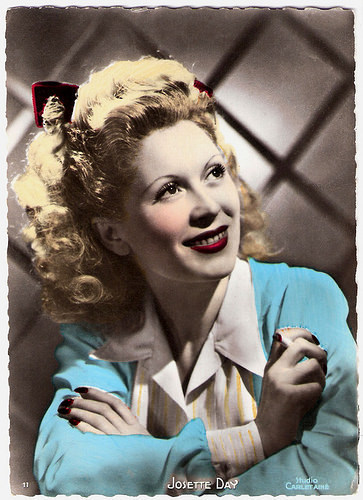
French postcard by Editions P.I., no. 11. Photo: Studio Carlet Ainé.
Trailer for La Belle et la bête (1946). Source: Criterion Trailers (YouTube)
Sources: James Travers (French Film Site), Bob Hufford (Find A Grave), (IMDb), Leonard W. Boasberg (Philadelphia Inquirer), Lenin Imports, Wikipedia and .

French postcard by Editions P.I., Paris, no. 11. Photo: Studio Piaz.

French postcard by Editions O.P., Paris, no. 15. Photo: Star.
Seven Films in a Year
Josette Day was born as Josette Noëlle Andrée Claire Dagory in Paris, in 1914.
At the age of five, she began her film career in Ames d'orient/Souls of the Orient (Léon Poirier, 1919). Till 1922 she made three films under her real name, Josette Dagory.
She also performed as a dancer, including a stint in the Paris Opera. An injury curtailed her career in dance when she was only 9 years old.
She did not return to the screen until she was an adult but then her film career soon took off. The sound film was recently introduced. As Josette Dagory she played the female lead in Serments/Oaths (Henri Fescourt, 1931) and Un bouquet de flirts/A bouquet of flirtations (Charles de Rochefort, 1931).
Then she changed her name to ‘Day’. Throughout the thirties she made numerous films, sometimes as many as seven in a year. Among her early sound films were the romantic comedy Allo Berlin? Ici Paris/Here's Berlin (Julien Duvivier, 1932), Coralie et Cie/Coralie and Company (Alberto Cavalcanti, 1933) starring Francoise Rosay , and Die Abenteuer des Königs Pausole/The Merry Monarch (Alexis Granowsky, 1933).
Die Abenteuer des Königs Pausole/The Merry Monarch was a Tobis production, that was made in a German, a French and an English version. In all three alternate language versions she was the leading lady opposite the famous Emil Jannings .
Later films were Les filles de la concierge/The Daughters of the Caretaker (Jacques Tourneur, 1934), Lucrèce Borgia/Lucrezia Borgia (Abel Gance, 1935) starring Edwige Feuillère , Ménilmontant (René Guissart, 1936), and L'homme du jour/The Man of the Hour (Julien Duvivier, 1937).

French (?) postcard by A.L.I., no. 39.

French postcard, no. PC 122.

French postcard by Editions et Publications Cinematographiques. Photo: Studio Arnal, Paris.

French postcard by A.N., Paris, no. 1009. Photo: Paramount. Collection: Didier Hanson.
Classic French Fairytale
In 1939, Josette Day met Marcel Pagnol and they had an affair. Pagnol was a famous French author, producer and director who owned his own film studio. Some sources say they were married, but on 2 July 1978, the French news paper Le Monde ran a correction of its obit of the day before. The union of Josette Day and Marcel Pagnol "was never consecrated by a marriage."
Her first great role was as Patricia Amoretti in his production La Fille du puisatier/The Well-Diggers Daughter (Marcel Pagnol, 1940) with Raimu and Fernandel . The couple also made Monsieur Brotonneau/Mr. Brotonneau (Alexander Esway, 1939) starring Raimu , La prière aux étoiles/The Prayer to the Stars (Marcel Pagnol, 1941) and Arlette et l'amour/Arlette and Love (Robert Vernay, 1943).
Day left Pagnol in 1944. Most of her films seem forgotten through the passage of time, except for one film for which she will always be remembered in the history of French cinema.
In 1946, she played Belle in the classic French fairy-tale La belle et la bête/Beauty and the Beast (Jean Cocteau, René Clément, 1946) opposite Jean Marais as the Beast.
At French Film Site , James Travers reviews: “This is one of the most important films in the history of cinema. By pushing film technology to its creative limits and avoiding sentimentality, Jean Cocteau succeeds in creating a film that is both visually entrancing and emotionally rewarding, whilst re-telling a familiar tale in a fresh and innovative way. (…) Of course, Cocteau is well-served by some great acting talent, in the form of Jean Marais and Josette Day as the lead characters.”
Two years after La belle et la bête she also appeared opposite Marais in Cocteau’s Les parents terrible/The Terrible Parents (1948), and she also appeared in his lost film Coriolan (Jean Cocteau, 1950).
Other interesting films were La révoltée/Stolen Affections (Marcel L’Herbier, 1948) with Victor Francen , and Swiss Tour/Four Days Leave (Leopold Lindtberg, 1950) with Cornell Wilde and Simone Signoret .
She was only 36 years old when she suddenly ended her career. She retired to marry a wealthy Belgian businessman, Maurice Solvay, whom she had hidden from the Nazis during World War II. She was only seen once in another film, as herself in the comedy L'amour, Madame/Love, Madame (Gilles Grangier, 1952) with Arletty and François Périer .
The last years of her life she devoted herself to charitable work. In 1960 her husvand had died. Josette Day died in 1978 in Paris. She was 63.
But was she really dead? 17 years later, Micheline Weill, an American woman living in a Philadelphia row house begged to differ to differ. In the Philadelphia Inquirer , she proclaimed: "I Am Alive" in lilting French. True? The writer, Leonard W. Boasberg, ends his article thus: "One thing is certain, if anything is certain in this world: She is not lying. She truly believes herself to be Josette Day. Possibly, her friend Tom Brady says, she is just a sweet and charming but confused old woman. On the other hand, he adds, if it seems almost too good to be true that she is Josette Day, that doesn't mean it isn't true."

French postcard by Editions P.I., no. 138. Photo: Star.

French postcard by Viny, no. 55. Photo: Star.

French postcard by Editions P.I., no. 138. Photo: Studio Carlet Ainé.

French postcard by Editions P.I., no. 11. Photo: Studio Carlet Ainé.
Trailer for La Belle et la bête (1946). Source: Criterion Trailers (YouTube)
Sources: James Travers (French Film Site), Bob Hufford (Find A Grave), (IMDb), Leonard W. Boasberg (Philadelphia Inquirer), Lenin Imports, Wikipedia and .
Published on February 12, 2015 22:00
February 11, 2015
Roger Hanin (1925-2015)
Yesterday, French actor and director Roger Hanin passed away, following a respiratory distress. Since 1953, he appeared in more than 100 French and foreign films, often playing tough guys in crime films. But he was best loved in France as TV Commissioner Navarro.
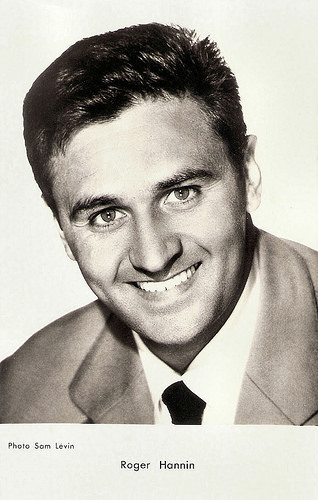
French postcard by Editions P.I., offered by Les Carbones Korès Carboplane, no. 1048 A. Photo: Sam Lévin.
Série noire
Roger Hanin was born as Roger Paul Lévy in 1925 in Algiers, then France, now Algeria, to Jewish parents. He went to Paris to follow a study pharmacy.
However, he quickly turned to acting, taking small roles in the theatre. His film debut was a small part in Le chemin de Damas/The Road to Damascus (Max Glass, 1952) with Michel Simon .
Then he played a bodyguard in the French crime film La môme vert-de-gris/Poison Ivy (1953). It was French director Bernard Borderie's first film, which made American-born actor Eddie Constantine a big star in Europe. The screenplay is based the on the 1937 Lemmy Caution thriller Poison Ivy by Peter Cheyney, which had been in 1945 the first title published in Marcel Duhamel's Série noire. The story involves FBI agent Caution investigating gold smuggling activity in Casablanca.
More parts in crime dramas followed, such as in Série noire (Pierre Foucaud, 1955) with Henri Vidal , and Gas-oil/Hi-Jack Highway (Gilles Grangier 1955), starring Jean Gabin and Jeanne Moreau .
Hanin also played a supporting role in the drama Celui qui doit mourir/He Who Must Die (Jules Dassin, 1957), based on the novel Christ Recrucified by Nikos Kazantzakis.
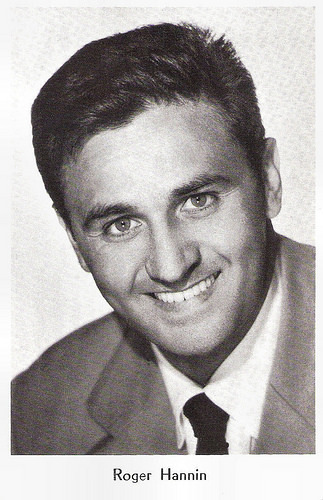
French collector's card by Biscottes Corvisart, Epinal. Photo: Sam Lévin.
Short tribute for Roger Hanin. Source: Mourn for You (YouTube)
Eurospy films
Roger Hanin also appeared in the Nouvelle Vague classic À bout de soufflé/Breathless (Jean-Luc Godard, 1960) about a wandering criminal ( Jean-Paul Belmondo ) and his American girlfriend (Jean Seberg). It was Godard's first feature-length work and represented Belmondo's breakthrough as an actor.
Another classic in which Hanin had a supporting part was Rocco e i suoi fratelli/Rocco and His Brothers (Luchino Visconti, 1960) featuring Alain Delon .
He started to play leading roles but in less interesting French films. In Italy, he co-starred in the comedy La marcia su Roma/March on Rome (Dino Risi, 1962), opposite Vittorio Gassman and Ugo Tognazzi.
With Claude Chabrol, Hanin co-wrote the scripts for the Eurospy films Le Tigre aime la chair fraiche/Code Name: Tiger (Claude Chabrol, 1964) and Le Tigre se parfume à la dynamite/Our Agent Tiger (Claude Chabrol, 1965), both featuring Hanin in the starring role of secret agent Le Tigre (the tiger). The films were an attempt to create a French franchise equal to James Bond.
It was not a success and soon Hanin returned to supporting parts as in The Brides of Fu Manchu (Don Sharp, 1966) starring Christopher Lee, Le clair de terre/Earth Light (Guy Gilles, 1970) and the Hollywood Western The Revengers (Daniel Mann, 1972) starring William Holden. In Italy, he appeared opposite Alain Delon in Ducio Tessari's action film Big Guns - Tony Arzenta (1973).
He started to direct films himself, such as Le protecteur/The Protector (Roger Hanin, 1974) with Bruno Cremer. In total he made 10 films and series, for the cinema and TV. His film Train d'enfer/Hell Train (Roger Hanin, 1985) was entered into the 14th Moscow International Film Festival where it won a Special Prize. In 1977, he founded the theatre festival of Pau.
He kept appearing in well-known films, such as in Les misérables (Robert Hossein, 1982) and often collaborated with director Alexandre Arcady such as at the Jewish mafia drama Le grand pardon/Day of Atonement (Alexandre Arcady, 1982) and the sequel Le Grand Pardon II/Day of Atonement (Alexandre Arcady, 1992).
In France, he is probably best known from TV as commissioner Navarro in the police series Navarro (1989–2006) and the sequel Brigade Navarro (2007-2009). In France the series was a colossal success. After shooting the final episode of Navarro he retired.
From 1959 till her death in 2002, Roger Hanin was married to producer Christine Gouze-Rénal. They often worked together on films. His brother-in-law was former President of France, the late François Mitterrand. Hanin was 89.
Roger Hanin and Enrico Macias sing Les Filles de Mon Pays. Source: Aranjmalar (YouTube).
French trailer for Le Grand Pardon II/Day of Atonement (Alexandre Arcady, 1992). Source: guiri47 (YouTube).
Sources: Thomas Sotinel (Le Monde - French), Wikipedia and .

French postcard by Editions P.I., offered by Les Carbones Korès Carboplane, no. 1048 A. Photo: Sam Lévin.
Série noire
Roger Hanin was born as Roger Paul Lévy in 1925 in Algiers, then France, now Algeria, to Jewish parents. He went to Paris to follow a study pharmacy.
However, he quickly turned to acting, taking small roles in the theatre. His film debut was a small part in Le chemin de Damas/The Road to Damascus (Max Glass, 1952) with Michel Simon .
Then he played a bodyguard in the French crime film La môme vert-de-gris/Poison Ivy (1953). It was French director Bernard Borderie's first film, which made American-born actor Eddie Constantine a big star in Europe. The screenplay is based the on the 1937 Lemmy Caution thriller Poison Ivy by Peter Cheyney, which had been in 1945 the first title published in Marcel Duhamel's Série noire. The story involves FBI agent Caution investigating gold smuggling activity in Casablanca.
More parts in crime dramas followed, such as in Série noire (Pierre Foucaud, 1955) with Henri Vidal , and Gas-oil/Hi-Jack Highway (Gilles Grangier 1955), starring Jean Gabin and Jeanne Moreau .
Hanin also played a supporting role in the drama Celui qui doit mourir/He Who Must Die (Jules Dassin, 1957), based on the novel Christ Recrucified by Nikos Kazantzakis.

French collector's card by Biscottes Corvisart, Epinal. Photo: Sam Lévin.
Short tribute for Roger Hanin. Source: Mourn for You (YouTube)
Eurospy films
Roger Hanin also appeared in the Nouvelle Vague classic À bout de soufflé/Breathless (Jean-Luc Godard, 1960) about a wandering criminal ( Jean-Paul Belmondo ) and his American girlfriend (Jean Seberg). It was Godard's first feature-length work and represented Belmondo's breakthrough as an actor.
Another classic in which Hanin had a supporting part was Rocco e i suoi fratelli/Rocco and His Brothers (Luchino Visconti, 1960) featuring Alain Delon .
He started to play leading roles but in less interesting French films. In Italy, he co-starred in the comedy La marcia su Roma/March on Rome (Dino Risi, 1962), opposite Vittorio Gassman and Ugo Tognazzi.
With Claude Chabrol, Hanin co-wrote the scripts for the Eurospy films Le Tigre aime la chair fraiche/Code Name: Tiger (Claude Chabrol, 1964) and Le Tigre se parfume à la dynamite/Our Agent Tiger (Claude Chabrol, 1965), both featuring Hanin in the starring role of secret agent Le Tigre (the tiger). The films were an attempt to create a French franchise equal to James Bond.
It was not a success and soon Hanin returned to supporting parts as in The Brides of Fu Manchu (Don Sharp, 1966) starring Christopher Lee, Le clair de terre/Earth Light (Guy Gilles, 1970) and the Hollywood Western The Revengers (Daniel Mann, 1972) starring William Holden. In Italy, he appeared opposite Alain Delon in Ducio Tessari's action film Big Guns - Tony Arzenta (1973).
He started to direct films himself, such as Le protecteur/The Protector (Roger Hanin, 1974) with Bruno Cremer. In total he made 10 films and series, for the cinema and TV. His film Train d'enfer/Hell Train (Roger Hanin, 1985) was entered into the 14th Moscow International Film Festival where it won a Special Prize. In 1977, he founded the theatre festival of Pau.
He kept appearing in well-known films, such as in Les misérables (Robert Hossein, 1982) and often collaborated with director Alexandre Arcady such as at the Jewish mafia drama Le grand pardon/Day of Atonement (Alexandre Arcady, 1982) and the sequel Le Grand Pardon II/Day of Atonement (Alexandre Arcady, 1992).
In France, he is probably best known from TV as commissioner Navarro in the police series Navarro (1989–2006) and the sequel Brigade Navarro (2007-2009). In France the series was a colossal success. After shooting the final episode of Navarro he retired.
From 1959 till her death in 2002, Roger Hanin was married to producer Christine Gouze-Rénal. They often worked together on films. His brother-in-law was former President of France, the late François Mitterrand. Hanin was 89.
Roger Hanin and Enrico Macias sing Les Filles de Mon Pays. Source: Aranjmalar (YouTube).
French trailer for Le Grand Pardon II/Day of Atonement (Alexandre Arcady, 1992). Source: guiri47 (YouTube).
Sources: Thomas Sotinel (Le Monde - French), Wikipedia and .
Published on February 11, 2015 22:00
February 10, 2015
Gerard Decaux
Today a post on another forgotten photographer whose pictures are on many film star postcards, Gerard Decaux. This French glamour photographer was very busy during the 1950s and 1960s.
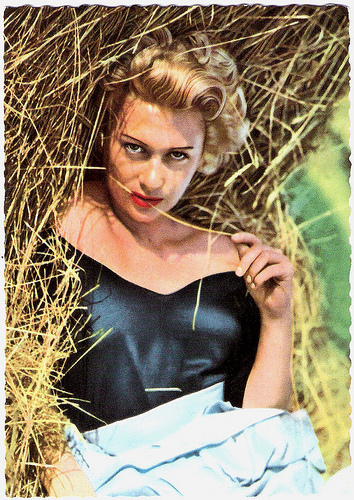
Martine Carol . German postcard by Universum-Film Aktiengesellschaft, Berlin-Tempelhof, no. CK-2. Retail price: 30 Pfg. Photo: Gerard Decaux / UFA.
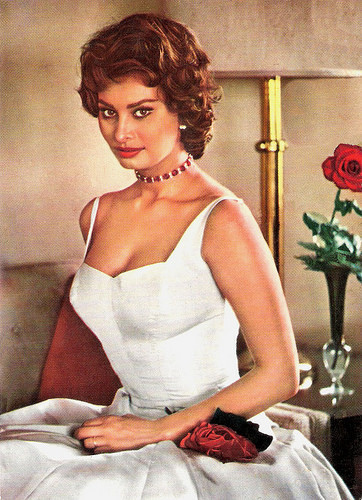
Sophia Loren . French postcard by Editions P.I., Paris. Photo: Gerard Decaux / UFA.
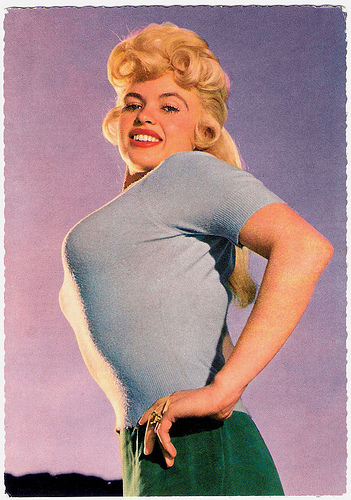
Jayne Mansfield . German postcard by Krüger, no. 902/392. Photo: Gerard Decaux.
Miss Freckles
We could find only a bit of information about Gerard Decaux on the net, but many of his pictures are retraceable. The French photographer made glamorous photos of French but also German, Italian and American celebrities for dozens of record sleeves, star postcards and magazines like CinéMonde and Paris Match.
His celebrity photos were distributed by international news agencies like Camera Press in London. On the net we found such a picture, he made of Miss Freckles. This was a nickname for half Norwegian, half Spanish cabaret star Vida Bendix. Bendix had appeared in the BBC show Cafe Continental and in the Spanish film Minutos antes/Minutes before (José Luis Gamboa, 1956).
Miss Freckles suddenly became news when she had been left a fortune after a lieutenant-commander Martin Solomon died mysteriously in his room in Madrid. The flip side of the press photo mentions that Solomon and Bendix were married in March 1956, a fact which was known only to a few people.
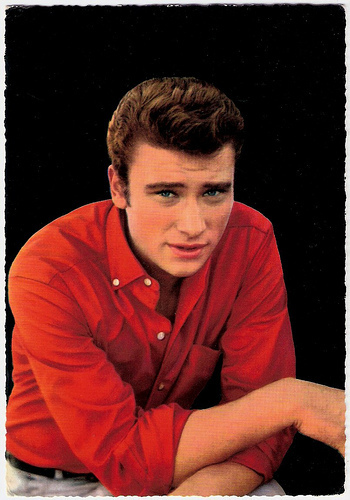
Johnny Hallyday . German postcard by Krüger, no. 902/228. Photo: Gérard Decaux.
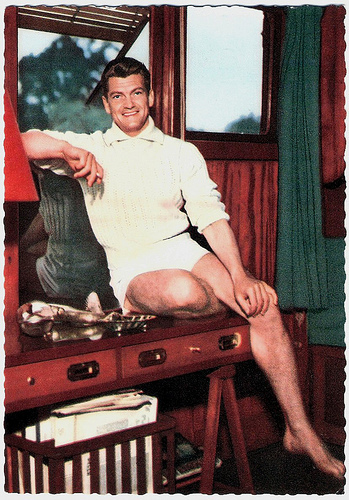
Jean Marais . German postcard by Universum-Film Aktiengesellschaft (UFA), Berlin-Tempelhof, no. CK-27. Retail price: 30 Pfg. Photo: Gerard Decaux / UFA.
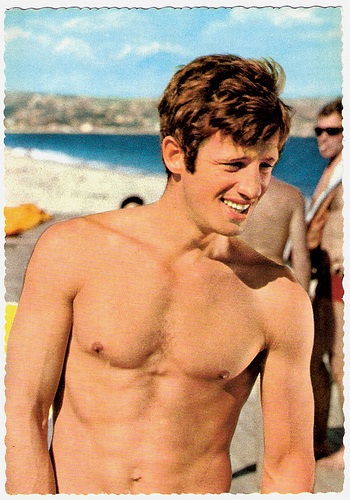
Jean-Paul Belmondo . German postcard by Krüger, no. 902/345. Photo: Gerard Decaux.

Jean-Pierre Cassel . German postcard by Krüger, no. 902/393. Photo: Gerard Decaux.
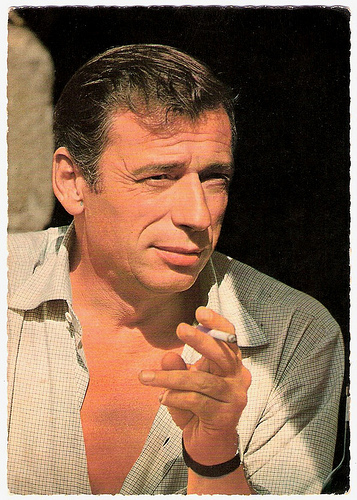
Yves Montand . German postcard by Krüger, no. 902/394. Photo: Gerard Decaux.
Saint Tropez Blues
Another wonderful photo by Gerard Decaux I found on the net is a 1965 picture of American film star Kim Novak with a Kodak Instamatic before her beautiful face. Decaux visited Montmartre with her and he clicked when she was photographing the Basilique du Sacré-Cœur de Montmartre. Wonderful.
Auction sites show that Decaux was also active as a fashion photographer, e.g. one of Marie-Helene Ariaud, photo model for Chanel, looking in a mirror. He also made wonderful street photos, e.g. a series at the Gare du Lyon, which was auctioned in 2013.
IMDb mentions that Gerard Decaux once appeared in a film, Saint Tropez Blues (1961), written and directed by Marcel Moussy. The film starred singer Marie Laforêt . Decaux also photographed her for a sleeve of one of her records and for the postcard below.
I really like Decaux' more wild and imaginative pictures like the one of the Kessler Twins : jumping and laughing in white bikinis in the open air. The picture was used by Polydor for the sleeve of their EP Roulette and for the German Krüger postcard here below.
Another crazy star photo is the one of American actress Yvette Mimieux climbing in a tree, which was also used by Krüger for a postcard. There are so many Krüger postcards with pictures by Gerard Decaux. Enjoy them!
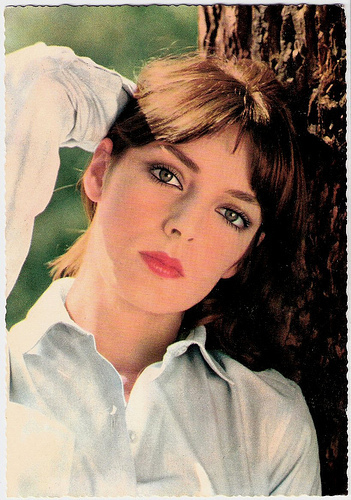
Marie Laforêt . German postcard by Krüger, no. 902/344. Photo: Gerard Decaux.
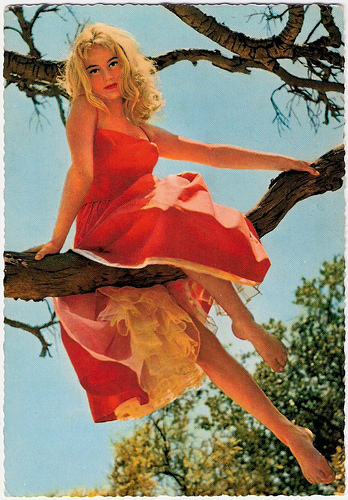
Yvette Mimieux. German postcard by Krüger, no. 902/370. Photo: Gerard Decaux.
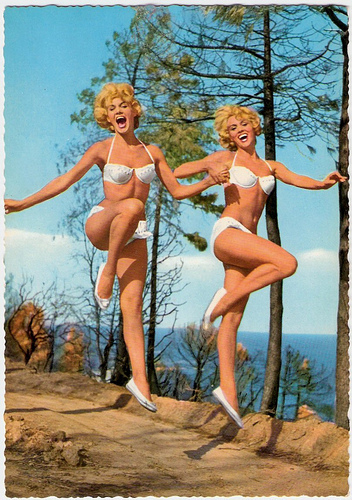
Alice & Ellen Kessler . German postcard by Krüger, no. 902/199. Photo: Gerard Decaux.
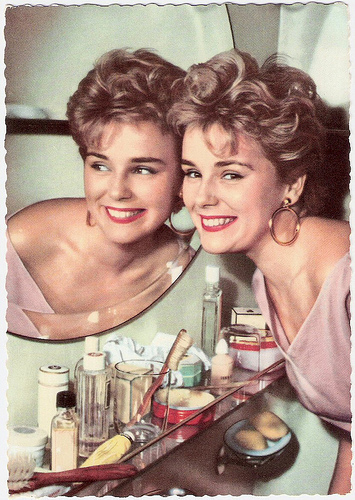
Susanne Cramer . German postcard by UFA (Universum-Film Aktiengesellschaft) Berlin-Tempelhof, no. CK-63. Retail price: 30 Pfg. Photo: Gerard Decaux / UFA.
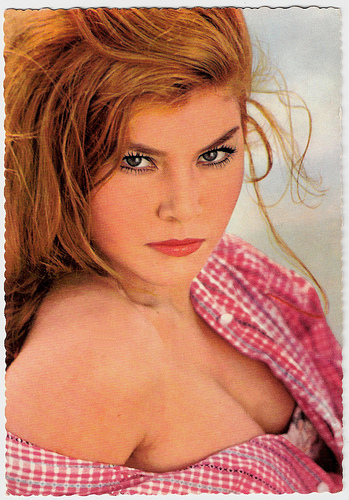
Claudia Mori . German postcard by Krüger, no. 902/342. Photo: Gerard Decaux.
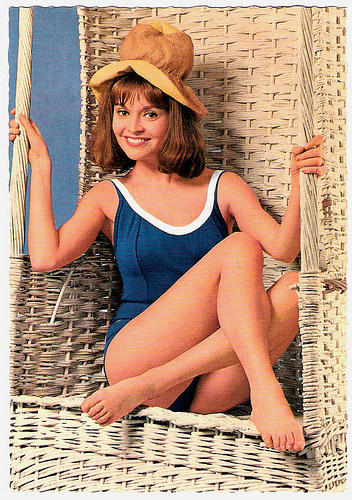
Yvonne Monlaur . German postcard by Krüger, no. 902/395. Photo: Gerard Decaux.
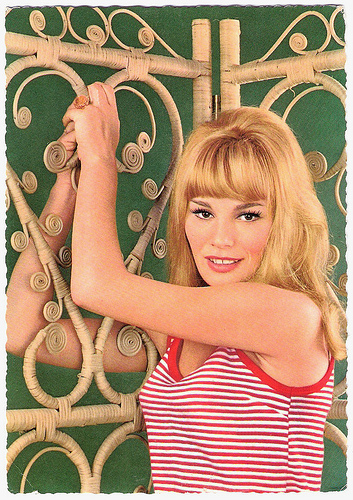
Catherine Franck . German postcard by Krüger, no. 902/339. Photo: Gerard Decaux.
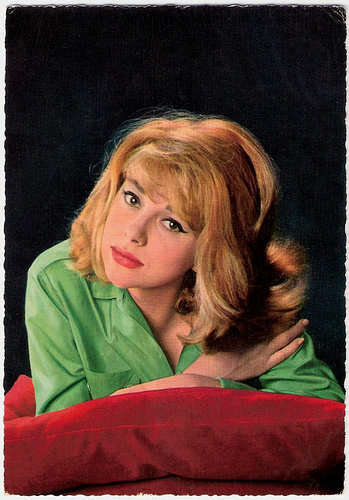
Mireille Darc . German postcard by Krüger, no. 902/197. Photo: Gerard Decaux.
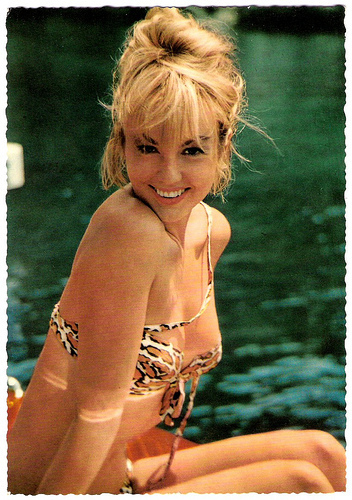
Mylène Demongeot . German postcard by Krüger, no. 902/326. Photo: Gerard Decaux.
Check out our other posts on film star photographers. See the links at right under the caption 'The Photographers'.
Sources: Artnet, Encyclopédisque, eBay, and .

Martine Carol . German postcard by Universum-Film Aktiengesellschaft, Berlin-Tempelhof, no. CK-2. Retail price: 30 Pfg. Photo: Gerard Decaux / UFA.

Sophia Loren . French postcard by Editions P.I., Paris. Photo: Gerard Decaux / UFA.

Jayne Mansfield . German postcard by Krüger, no. 902/392. Photo: Gerard Decaux.
Miss Freckles
We could find only a bit of information about Gerard Decaux on the net, but many of his pictures are retraceable. The French photographer made glamorous photos of French but also German, Italian and American celebrities for dozens of record sleeves, star postcards and magazines like CinéMonde and Paris Match.
His celebrity photos were distributed by international news agencies like Camera Press in London. On the net we found such a picture, he made of Miss Freckles. This was a nickname for half Norwegian, half Spanish cabaret star Vida Bendix. Bendix had appeared in the BBC show Cafe Continental and in the Spanish film Minutos antes/Minutes before (José Luis Gamboa, 1956).
Miss Freckles suddenly became news when she had been left a fortune after a lieutenant-commander Martin Solomon died mysteriously in his room in Madrid. The flip side of the press photo mentions that Solomon and Bendix were married in March 1956, a fact which was known only to a few people.

Johnny Hallyday . German postcard by Krüger, no. 902/228. Photo: Gérard Decaux.

Jean Marais . German postcard by Universum-Film Aktiengesellschaft (UFA), Berlin-Tempelhof, no. CK-27. Retail price: 30 Pfg. Photo: Gerard Decaux / UFA.

Jean-Paul Belmondo . German postcard by Krüger, no. 902/345. Photo: Gerard Decaux.

Jean-Pierre Cassel . German postcard by Krüger, no. 902/393. Photo: Gerard Decaux.

Yves Montand . German postcard by Krüger, no. 902/394. Photo: Gerard Decaux.
Saint Tropez Blues
Another wonderful photo by Gerard Decaux I found on the net is a 1965 picture of American film star Kim Novak with a Kodak Instamatic before her beautiful face. Decaux visited Montmartre with her and he clicked when she was photographing the Basilique du Sacré-Cœur de Montmartre. Wonderful.
Auction sites show that Decaux was also active as a fashion photographer, e.g. one of Marie-Helene Ariaud, photo model for Chanel, looking in a mirror. He also made wonderful street photos, e.g. a series at the Gare du Lyon, which was auctioned in 2013.
IMDb mentions that Gerard Decaux once appeared in a film, Saint Tropez Blues (1961), written and directed by Marcel Moussy. The film starred singer Marie Laforêt . Decaux also photographed her for a sleeve of one of her records and for the postcard below.
I really like Decaux' more wild and imaginative pictures like the one of the Kessler Twins : jumping and laughing in white bikinis in the open air. The picture was used by Polydor for the sleeve of their EP Roulette and for the German Krüger postcard here below.
Another crazy star photo is the one of American actress Yvette Mimieux climbing in a tree, which was also used by Krüger for a postcard. There are so many Krüger postcards with pictures by Gerard Decaux. Enjoy them!

Marie Laforêt . German postcard by Krüger, no. 902/344. Photo: Gerard Decaux.

Yvette Mimieux. German postcard by Krüger, no. 902/370. Photo: Gerard Decaux.

Alice & Ellen Kessler . German postcard by Krüger, no. 902/199. Photo: Gerard Decaux.

Susanne Cramer . German postcard by UFA (Universum-Film Aktiengesellschaft) Berlin-Tempelhof, no. CK-63. Retail price: 30 Pfg. Photo: Gerard Decaux / UFA.

Claudia Mori . German postcard by Krüger, no. 902/342. Photo: Gerard Decaux.

Yvonne Monlaur . German postcard by Krüger, no. 902/395. Photo: Gerard Decaux.

Catherine Franck . German postcard by Krüger, no. 902/339. Photo: Gerard Decaux.

Mireille Darc . German postcard by Krüger, no. 902/197. Photo: Gerard Decaux.

Mylène Demongeot . German postcard by Krüger, no. 902/326. Photo: Gerard Decaux.
Check out our other posts on film star photographers. See the links at right under the caption 'The Photographers'.
Sources: Artnet, Encyclopédisque, eBay, and .
Published on February 10, 2015 22:00
February 9, 2015
Alma Taylor
Blue-eyed, round-faced Alma Taylor (1895-1974) was a British actress, who peeked in the British silent cinema of the 1910s and 1920s. In 1915 readers of Pictures and Picturegoers voted her most popular British performer, beating even Charlie Chaplin. Taylor acted in over 150 films, among which some prestigious examples like Shadow of Egypt (Sidney Morgan, 1924), filmed on location in Egypt.
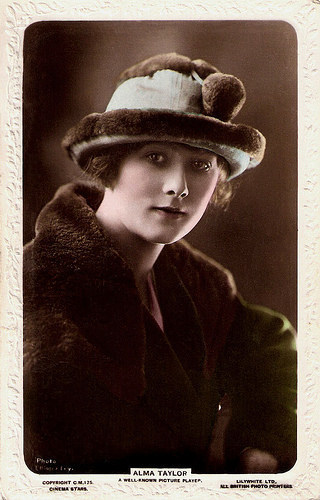
British postcard in the Lilywhite Photographic Series.
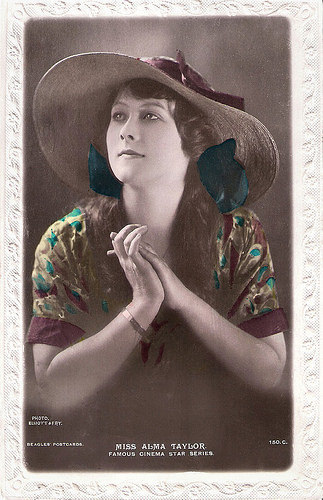
British postcard by Beagles in the Famous Cinema Star Series, no. 150 C. Photo: Elliott & Fry.
Hepworth' favourite
Alma Taylor was born in London, Great Britain, in 1895. According to Anthony Slide, brunette, blue-eyed she was the Hepworth actress 'par excellence'. Beginning as a child in 1907, Alma Taylor already acted with producer Cecil Hepworth, playing tragic young girls in his short silent films.
The photogenic brunette then co-starred with Chrissie White in Hepworth's 'Tilly the Tomboy' comedy series (1910-1915) about two naughty schoolgirls.
Hans J. Wollstein at AllMovie : "The other Tilly girl was Chrissie White and each in her own way would come to personify the typical British silent screen heroine: innocuous, well-mannered, and invariably dressed for comfort."
Taylor would appear in 75 or more short and long subjects by Hepworth, such as the Charles Dickens adaptations Oliver Twist (Thomas Bentley, 1912) as Nancy, David Copperfield (Thomas Bentley, 1913) and The Old Curiosity Shop (Thomas Bentley, 1913).
In those days, everyone helped out at the studios, so both Alma and Chrissie helped in the processing rooms when the weather was too poor to shoot.
During the First World War and soon after Taylor contributed to the war effort by acting in such propaganda films like The Nature of the Beast (Cecil Hepworth, 1919).
Taylor clearly was the producer's favourite, and remained devoted to him for decades. In 1923, she starred opposite Ralph Forbes in the rather old-fashioned British countryside drama Comin' Thro the Rye (Cecil Hepworth, 1923), a remake of an earlier version by Hepworth.
Taylor played her usual heroine, suffering nobly and at great length after losing her man to another woman.
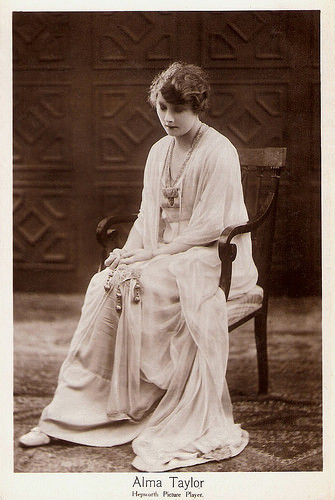
British postcard. Photo: Hepworth.

British postcard. Photo: Hepworth.
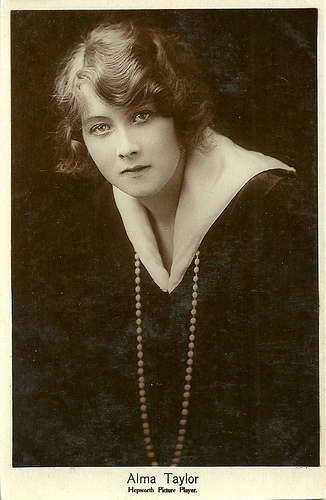
British postcard. Photo: Hepworth.
Britain's top star
After a temporal absence from the screen, Cecil Hepworth re-launched Alma Taylor in his last film, The House of Marney (Cecil Hepworth, 1926), with John Longden.
In 1924, the Daily News named Alma Taylor, along with Betty Balfour , 'Britain's top star'. Taylor only starred in four non-Hepworth films: The Shadow of Egypt (Sidney Morgan, 1924) with Joan Morgan, Quinneys (Maurice Elvey, 1927), A South Sea Bubble (T. Hays Hunter, 1928) with Ivor Novello , and Two Little Drummer Boys (G.B.Samuelson, 1928).
In the late silent era, she did some German films, including her part of Mrs. Barrymore in Der Hund von Baskerville/The Hound of the Baskervilles (Richard Oswald, 1929). This film was considered lost for a long time, but it was rediscovered in 2009.
With the coming of sound, however, Taylor's career dwindled and she had to be satisfied with minor, matronly roles, in s small number of films. These included Bachelor's Baby (Harry Hughes, 1932), Things Are Looking Up (Albert de Courville, 1935), Lilacs in the Spring (Herbert Wilcox, 1954), and Blue Murder at St. Trinian's (Frank Launder, 1957).
Uncredited, she played a box office woman in Hitchcock's second version of The Man Who Knew Too Much (Alfred Hitchcock, 1956).
Probably her last part was the uncredited role of an old lady in the Titanic-drama by Rank, A Night to Remember (Roy Ward Baker, 1958).
Alma Taylor died in London, in 1974. She was the wife of film producer and director Walter West (1885-1958). In the late 1910s and early 1920s, West was the regular director of Violet Hopson , first with his company Broadwest (1914-1921) and then for Hopson's own company.
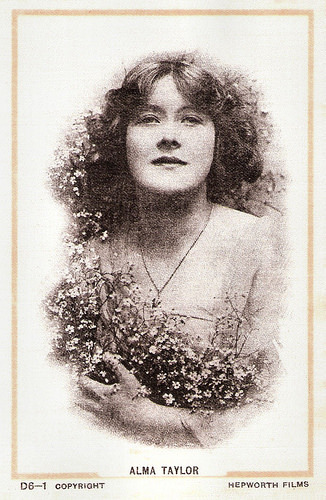
British postcard by Hepworth Films, no. D6-1.
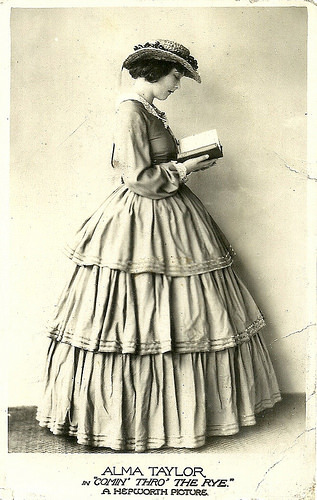
British postcard by TIC. Photo: Hepworth. Publicity still for Comin' Thro the Rye (Cecil Hepworth, 1923).
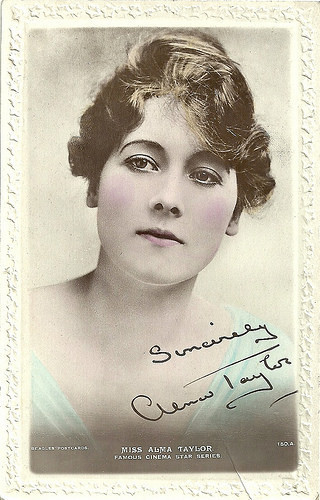
British postcard by Beagles in the Famous Cinema Star Series, no. 150A.
Sources: Anthony Slide (Encyclopedia of British Film), Hans J. Wollstein (AllMovie), Hepworthfilm, Wikipedia and .

British postcard in the Lilywhite Photographic Series.

British postcard by Beagles in the Famous Cinema Star Series, no. 150 C. Photo: Elliott & Fry.
Hepworth' favourite
Alma Taylor was born in London, Great Britain, in 1895. According to Anthony Slide, brunette, blue-eyed she was the Hepworth actress 'par excellence'. Beginning as a child in 1907, Alma Taylor already acted with producer Cecil Hepworth, playing tragic young girls in his short silent films.
The photogenic brunette then co-starred with Chrissie White in Hepworth's 'Tilly the Tomboy' comedy series (1910-1915) about two naughty schoolgirls.
Hans J. Wollstein at AllMovie : "The other Tilly girl was Chrissie White and each in her own way would come to personify the typical British silent screen heroine: innocuous, well-mannered, and invariably dressed for comfort."
Taylor would appear in 75 or more short and long subjects by Hepworth, such as the Charles Dickens adaptations Oliver Twist (Thomas Bentley, 1912) as Nancy, David Copperfield (Thomas Bentley, 1913) and The Old Curiosity Shop (Thomas Bentley, 1913).
In those days, everyone helped out at the studios, so both Alma and Chrissie helped in the processing rooms when the weather was too poor to shoot.
During the First World War and soon after Taylor contributed to the war effort by acting in such propaganda films like The Nature of the Beast (Cecil Hepworth, 1919).
Taylor clearly was the producer's favourite, and remained devoted to him for decades. In 1923, she starred opposite Ralph Forbes in the rather old-fashioned British countryside drama Comin' Thro the Rye (Cecil Hepworth, 1923), a remake of an earlier version by Hepworth.
Taylor played her usual heroine, suffering nobly and at great length after losing her man to another woman.

British postcard. Photo: Hepworth.

British postcard. Photo: Hepworth.

British postcard. Photo: Hepworth.
Britain's top star
After a temporal absence from the screen, Cecil Hepworth re-launched Alma Taylor in his last film, The House of Marney (Cecil Hepworth, 1926), with John Longden.
In 1924, the Daily News named Alma Taylor, along with Betty Balfour , 'Britain's top star'. Taylor only starred in four non-Hepworth films: The Shadow of Egypt (Sidney Morgan, 1924) with Joan Morgan, Quinneys (Maurice Elvey, 1927), A South Sea Bubble (T. Hays Hunter, 1928) with Ivor Novello , and Two Little Drummer Boys (G.B.Samuelson, 1928).
In the late silent era, she did some German films, including her part of Mrs. Barrymore in Der Hund von Baskerville/The Hound of the Baskervilles (Richard Oswald, 1929). This film was considered lost for a long time, but it was rediscovered in 2009.
With the coming of sound, however, Taylor's career dwindled and she had to be satisfied with minor, matronly roles, in s small number of films. These included Bachelor's Baby (Harry Hughes, 1932), Things Are Looking Up (Albert de Courville, 1935), Lilacs in the Spring (Herbert Wilcox, 1954), and Blue Murder at St. Trinian's (Frank Launder, 1957).
Uncredited, she played a box office woman in Hitchcock's second version of The Man Who Knew Too Much (Alfred Hitchcock, 1956).
Probably her last part was the uncredited role of an old lady in the Titanic-drama by Rank, A Night to Remember (Roy Ward Baker, 1958).
Alma Taylor died in London, in 1974. She was the wife of film producer and director Walter West (1885-1958). In the late 1910s and early 1920s, West was the regular director of Violet Hopson , first with his company Broadwest (1914-1921) and then for Hopson's own company.

British postcard by Hepworth Films, no. D6-1.

British postcard by TIC. Photo: Hepworth. Publicity still for Comin' Thro the Rye (Cecil Hepworth, 1923).

British postcard by Beagles in the Famous Cinema Star Series, no. 150A.
Sources: Anthony Slide (Encyclopedia of British Film), Hans J. Wollstein (AllMovie), Hepworthfilm, Wikipedia and .
Published on February 09, 2015 22:00
February 8, 2015
Laura Antonelli
Beautiful and sexy Italian film actress Laura Antonelli (1941) appeared in 45 films between 1965 and 1991.

Romanian postcard by Casa Filmului Acin, no. C.P.C.S. C. da 43.142.
Dr. Goldfoot and the Girl Bombs
Laura Antonelli was born Laura Antonaz in 1941 in Pola (now Pula, Croatia), which at the time was the capital of the Italian province of Istria. She moved with her family first to Genoa and then to Venice, before they all eventually settled in Naples.
She had a childhood interest in education, and as a teenager she became proficient at gymnastics. Setting aside ambitions to make a career in mathematics, she graduated as a gymnastics instructor. She moved to Rome, where she became a secondary school gym teacher and was able to meet people in the entertainment industry, who helped her find modelling jobs.
Antonelli's earliest engagements included Italian advertisements for Coca Cola and appearances on the TV show Carosello (1957-1977). In 1965, she made her first, uncredited film appearance in Le sedicenni/16 Year Olds (Luigi Petrini, 1965).
Her 'American' debut came was in Dr. Goldfoot and the Girl Bombs (Mario Bava, 1966), an Italian-American coproduction starring Vincent Price. Two versions of the film were made, Italian and American. The American version was re-written, re-scored and re-edited without the participation of Mario Bava. The film was not particularly successful. According to Wikipedia it is considered by many critics to be director Bava's worst film yet it was his commercially most successful film in Italy.
Vincent Price's Goldfoot is the only character who appears in both versions. American distributor Samuel Z. Arkoff said the film's commercial reception was hurt by the refusal of Laura Antonelli to take her clothes off. Arkoff claimed she was originally willing to, but then his nephew, Ted Rusoff, who was sent to supervise the film, developed a crush on her and persuaded her not to do it.
Other roles for Antonelli followed. She appeared in a number of sexy films such as the erotic drama Venere in pelliccia/Venus in Furs (Massimo Dallamano, 1969) and Il merlo maschio/The Male Blackbird (Pasquale Festa Campanile, 1971) about a frustrated cello player (Lando Buzzanca), who exposes his wife (Antonelli) in a reworking of the renowned photograph by Man Ray.
In 1971, she also appeared opposite Jean-Paul Belmondo in the successful French comedy Les Mariés de l'an Deux/The Married Couple of the Year Two (Jean-Paul Rappeneau, 1971) and the two stars also privately had a long-time affair. She did more French films with Belmondo, such as the black comedy Dr. Popaul (Claude Chabrol, 1972).
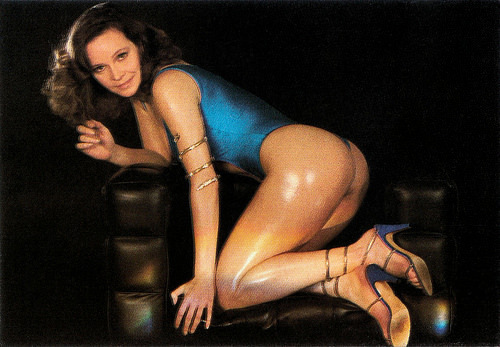
Italian postcard by Playboy edizioni Italiana, no. 2, 1982. Photo: Roberto Rocchi.
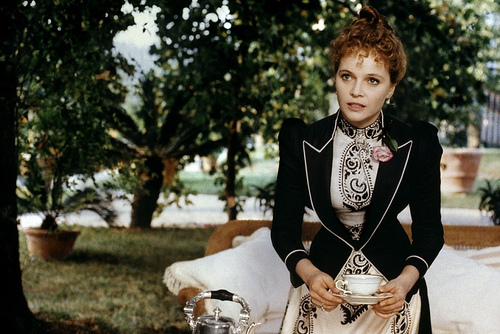
Laura Antonelli in L'innocente/The Innocent (1976). Photo: collection Véronique@Flickr.
Sexual awakening
In 1973, Laura Antonelli had her breakthrough with the comedy Malizia/Malicious (Salvatore Samperi, 1973) for which she won the Italian National Syndicate of Film Journalists Award, Nastro d'Argento in 1974. The film is about the parallel desire of a widower and his three teenage sons for their new housekeeper. The film challenged sexual taboos by presenting and mixing such themes as a 14 years old boy (Alessandro Momo) who blackmails the housekeeper into eventually tolerating his increasingly aggressive physical sexual harassment.
In the same year, she also had a huge commercial success with the anthology comedy Sessomatto/How Funny Can Sex Be? (Dino Risi, 1973). From then on, she played leading roles in some major films.
In Luchino Visconti's last film, L'innocente/The Innocent (1976) she played the wife of Giancarlo Giannini. Based on a novel by Gabriele d'Annunzio, the film is set amongst the aristocracy of 19th-century Italy. Wealthy Tullio (Giannini) thinks nothing of squiring his mistress (Jennifer O'Neill) in full view of his friends and the public. But when Giannini's cast-off wife (Antonelli) begins an affair with a young novelist, it is too much for the philandering aristocrat.
In the romance Mogliamante/Wifemistress (Marco Vicario, 1977) with Marcello Mastroianni, she played a repressed wife experiencing a sexual awakening. Later she appeared in Passione d'Amore/Passion of Love (Ettore Scola, 1981). Antonelli's final role was in the sequel Malizia 2000/Malice 2000 (Salvatore Samperi, 1991).
In 1991, cocaine was found during a police raid on Antonelli's home. She was subsequently convicted of possession and dealing and sentenced to house arrest. She spent ten years appealing the conviction which was eventually overturned. In 2006 the Italian court of appeals ruled in the favour of Antonelli and ordered to pay the former actress 108,000 euros.
Trailer L'innocente/The Innocent (1976). Source: Pierre Marascia (YouTube).
Sources: Hal Erickson (AllMovie), Wikipedia and .

Romanian postcard by Casa Filmului Acin, no. C.P.C.S. C. da 43.142.
Dr. Goldfoot and the Girl Bombs
Laura Antonelli was born Laura Antonaz in 1941 in Pola (now Pula, Croatia), which at the time was the capital of the Italian province of Istria. She moved with her family first to Genoa and then to Venice, before they all eventually settled in Naples.
She had a childhood interest in education, and as a teenager she became proficient at gymnastics. Setting aside ambitions to make a career in mathematics, she graduated as a gymnastics instructor. She moved to Rome, where she became a secondary school gym teacher and was able to meet people in the entertainment industry, who helped her find modelling jobs.
Antonelli's earliest engagements included Italian advertisements for Coca Cola and appearances on the TV show Carosello (1957-1977). In 1965, she made her first, uncredited film appearance in Le sedicenni/16 Year Olds (Luigi Petrini, 1965).
Her 'American' debut came was in Dr. Goldfoot and the Girl Bombs (Mario Bava, 1966), an Italian-American coproduction starring Vincent Price. Two versions of the film were made, Italian and American. The American version was re-written, re-scored and re-edited without the participation of Mario Bava. The film was not particularly successful. According to Wikipedia it is considered by many critics to be director Bava's worst film yet it was his commercially most successful film in Italy.
Vincent Price's Goldfoot is the only character who appears in both versions. American distributor Samuel Z. Arkoff said the film's commercial reception was hurt by the refusal of Laura Antonelli to take her clothes off. Arkoff claimed she was originally willing to, but then his nephew, Ted Rusoff, who was sent to supervise the film, developed a crush on her and persuaded her not to do it.
Other roles for Antonelli followed. She appeared in a number of sexy films such as the erotic drama Venere in pelliccia/Venus in Furs (Massimo Dallamano, 1969) and Il merlo maschio/The Male Blackbird (Pasquale Festa Campanile, 1971) about a frustrated cello player (Lando Buzzanca), who exposes his wife (Antonelli) in a reworking of the renowned photograph by Man Ray.
In 1971, she also appeared opposite Jean-Paul Belmondo in the successful French comedy Les Mariés de l'an Deux/The Married Couple of the Year Two (Jean-Paul Rappeneau, 1971) and the two stars also privately had a long-time affair. She did more French films with Belmondo, such as the black comedy Dr. Popaul (Claude Chabrol, 1972).

Italian postcard by Playboy edizioni Italiana, no. 2, 1982. Photo: Roberto Rocchi.

Laura Antonelli in L'innocente/The Innocent (1976). Photo: collection Véronique@Flickr.
Sexual awakening
In 1973, Laura Antonelli had her breakthrough with the comedy Malizia/Malicious (Salvatore Samperi, 1973) for which she won the Italian National Syndicate of Film Journalists Award, Nastro d'Argento in 1974. The film is about the parallel desire of a widower and his three teenage sons for their new housekeeper. The film challenged sexual taboos by presenting and mixing such themes as a 14 years old boy (Alessandro Momo) who blackmails the housekeeper into eventually tolerating his increasingly aggressive physical sexual harassment.
In the same year, she also had a huge commercial success with the anthology comedy Sessomatto/How Funny Can Sex Be? (Dino Risi, 1973). From then on, she played leading roles in some major films.
In Luchino Visconti's last film, L'innocente/The Innocent (1976) she played the wife of Giancarlo Giannini. Based on a novel by Gabriele d'Annunzio, the film is set amongst the aristocracy of 19th-century Italy. Wealthy Tullio (Giannini) thinks nothing of squiring his mistress (Jennifer O'Neill) in full view of his friends and the public. But when Giannini's cast-off wife (Antonelli) begins an affair with a young novelist, it is too much for the philandering aristocrat.
In the romance Mogliamante/Wifemistress (Marco Vicario, 1977) with Marcello Mastroianni, she played a repressed wife experiencing a sexual awakening. Later she appeared in Passione d'Amore/Passion of Love (Ettore Scola, 1981). Antonelli's final role was in the sequel Malizia 2000/Malice 2000 (Salvatore Samperi, 1991).
In 1991, cocaine was found during a police raid on Antonelli's home. She was subsequently convicted of possession and dealing and sentenced to house arrest. She spent ten years appealing the conviction which was eventually overturned. In 2006 the Italian court of appeals ruled in the favour of Antonelli and ordered to pay the former actress 108,000 euros.
Trailer L'innocente/The Innocent (1976). Source: Pierre Marascia (YouTube).
Sources: Hal Erickson (AllMovie), Wikipedia and .
Published on February 08, 2015 22:00
February 7, 2015
Zanny Petersen
Zanny Petersen (1892-1976) was a Danish stage actress, who also starred in the Danish silent cinema. Between 1912 and 1917, she appeared in 40 films for Nordisk Film.
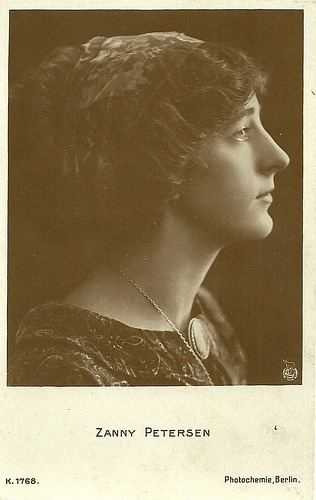
German postcard by Photochemie, Berlin, no. K.1768. Photo: Nordisk Film.
A Trip to Mars
Zanny Christiane Petersen was born in Copenhagen, Denmark, in 1892. She was the daughter of master painter Herman Petersen and Minna Petersen.
From 1911 Zanny Petersen studied at Det kongelige Teaters elevskole (the Royal Theatre School) and debuted at Det kongelige Teater (the Royal Theatre) in 1913 as Agnes in Johan Ludvig Heiberg’s comedy Elverhøj/The Elves’ Hill, considered the first Danish national play. In 1913-1914, she joined Det ny Teater (the New Theatre), and continued to act on stage until 1922, when she married and quitted her career.
During her theatre education, Petersen also worked as an extra at Nordisk Film and thus developed her film career. Probably her first substantial role was in Haevnen er sød/Revenge is Sweet (William Augustinus, 1911).
From 1911 to 1917, Zanny Petersen performed in over 40 films for Nordisk, including big productions such as Pax Aeterna/Peace on Earth (Holger-Madsen, 1917) and Himmelskibet/A Trip to Mars (Holger-Madsen, 1918) starring Gunnar Tolnaes .
She first worked under direction of directors like August Blom and Eduard Schnedder-Sørensen, and later on mainly with Holger-Madsen.
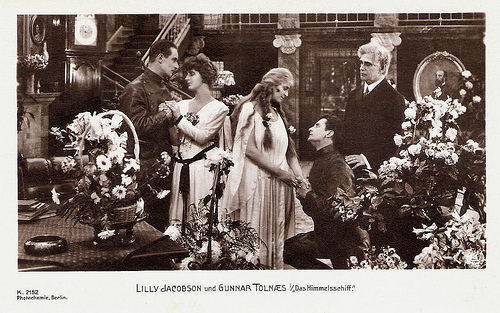
German postcard by Photochemie, Berlin, no. K.2152. Publicity still for the science-fiction film Himmelskibet/ Das Himmelschiff (Holger-Madsen, 1918). From left to right Alf Blütecher as Dr. Krafft, Zanny Petersen as Corona Planetaros, Lilly Jacobsson as Marya, Gunnar Tolnaes as Avanti Planetaros, and Nicolai Neiiendam as professor Planetaros, father of Corona and Avanti.
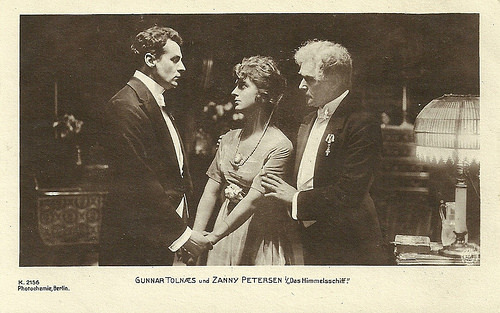
German postcard by Photochemie, Berlin, no. K. 2156. Photo: Nordisk. Publicity still for the science-fiction film Himmelskibet/ Das Himmelschiff (Holger-Madsen, 1918). This card shows Gunnar Tolnaes as captian Avanti Planetaros, Zanny Petersen as his sister Corona, and Nicolai Neiiendam as their father, the astronomer professor Planetaros.
The Opium Smoker
When starting to act at Nordisk, Zanny Petersen was only 17. So she often played the innocent young girls and daughters of the protagonists. She appeared opposite male stars like Carlo Wieth in Ekspeditricen/Saleslady (August Blom, 1911) and Valdemar Psilander in Lydia (Holger-Madsen, 1918).
Sometimes she was the female protagonist herself as in Opiumsdrømmen/The Opium Smoker (Holger-Madsen, 1917).
In September 1917 the worsening economic situation caused by the First World War forced Nordisk to end their contract with some 50 actors, including Zanny Petersen.
Together with actors Philip Bech and Alf Blütecher she went to court and won on the basis of unfair dismissal. Nordisk had to pay her indemnities at the height of her salary for the remaining years of the contract.
In addition to Nordisk, Petersen also acted at Kinografen and Filmfabriken Danmark. New films for Nordisk she had made before her break continued to be released in 1918 and even 1919, the last one being Hendes Helt/Completely for her (Holger-Madsen, 1919).
In 1922 Petersen married doctor Poul Jacob Ernst. In the mid-1930s amidst a Christian revival, they focused on helping their fellow men, including prisoners. Because of this calling Petersen completely stopped her career: "Movie Time, fame and all that went along with it, well, it was just theatre, menial theatre."
Zanny Petersen died in 1976 in Copenhagen and lies buried at the Old Cemetery in Frederiksberg.

German postcard by Photochemie, Berlin, no. K. 1662. Photo: Nordisk. With Gunnar Tolnaes.
Source: Danish Film Institute, Wikipedia (Danish) and .

German postcard by Photochemie, Berlin, no. K.1768. Photo: Nordisk Film.
A Trip to Mars
Zanny Christiane Petersen was born in Copenhagen, Denmark, in 1892. She was the daughter of master painter Herman Petersen and Minna Petersen.
From 1911 Zanny Petersen studied at Det kongelige Teaters elevskole (the Royal Theatre School) and debuted at Det kongelige Teater (the Royal Theatre) in 1913 as Agnes in Johan Ludvig Heiberg’s comedy Elverhøj/The Elves’ Hill, considered the first Danish national play. In 1913-1914, she joined Det ny Teater (the New Theatre), and continued to act on stage until 1922, when she married and quitted her career.
During her theatre education, Petersen also worked as an extra at Nordisk Film and thus developed her film career. Probably her first substantial role was in Haevnen er sød/Revenge is Sweet (William Augustinus, 1911).
From 1911 to 1917, Zanny Petersen performed in over 40 films for Nordisk, including big productions such as Pax Aeterna/Peace on Earth (Holger-Madsen, 1917) and Himmelskibet/A Trip to Mars (Holger-Madsen, 1918) starring Gunnar Tolnaes .
She first worked under direction of directors like August Blom and Eduard Schnedder-Sørensen, and later on mainly with Holger-Madsen.

German postcard by Photochemie, Berlin, no. K.2152. Publicity still for the science-fiction film Himmelskibet/ Das Himmelschiff (Holger-Madsen, 1918). From left to right Alf Blütecher as Dr. Krafft, Zanny Petersen as Corona Planetaros, Lilly Jacobsson as Marya, Gunnar Tolnaes as Avanti Planetaros, and Nicolai Neiiendam as professor Planetaros, father of Corona and Avanti.

German postcard by Photochemie, Berlin, no. K. 2156. Photo: Nordisk. Publicity still for the science-fiction film Himmelskibet/ Das Himmelschiff (Holger-Madsen, 1918). This card shows Gunnar Tolnaes as captian Avanti Planetaros, Zanny Petersen as his sister Corona, and Nicolai Neiiendam as their father, the astronomer professor Planetaros.
The Opium Smoker
When starting to act at Nordisk, Zanny Petersen was only 17. So she often played the innocent young girls and daughters of the protagonists. She appeared opposite male stars like Carlo Wieth in Ekspeditricen/Saleslady (August Blom, 1911) and Valdemar Psilander in Lydia (Holger-Madsen, 1918).
Sometimes she was the female protagonist herself as in Opiumsdrømmen/The Opium Smoker (Holger-Madsen, 1917).
In September 1917 the worsening economic situation caused by the First World War forced Nordisk to end their contract with some 50 actors, including Zanny Petersen.
Together with actors Philip Bech and Alf Blütecher she went to court and won on the basis of unfair dismissal. Nordisk had to pay her indemnities at the height of her salary for the remaining years of the contract.
In addition to Nordisk, Petersen also acted at Kinografen and Filmfabriken Danmark. New films for Nordisk she had made before her break continued to be released in 1918 and even 1919, the last one being Hendes Helt/Completely for her (Holger-Madsen, 1919).
In 1922 Petersen married doctor Poul Jacob Ernst. In the mid-1930s amidst a Christian revival, they focused on helping their fellow men, including prisoners. Because of this calling Petersen completely stopped her career: "Movie Time, fame and all that went along with it, well, it was just theatre, menial theatre."
Zanny Petersen died in 1976 in Copenhagen and lies buried at the Old Cemetery in Frederiksberg.

German postcard by Photochemie, Berlin, no. K. 1662. Photo: Nordisk. With Gunnar Tolnaes.
Source: Danish Film Institute, Wikipedia (Danish) and .
Published on February 07, 2015 22:00
February 6, 2015
La statua di carne (1921)
La statua di carne/The statue of flesh (1921) is a silent Italian film directed by Mario Almirante. The stars are his wife, diva Italia Almirante Manzini and Lido Manetti a.k.a. Arnold Kent. Italia Almirante plays a beautiful, worldly femme fatale, who falls in love with a man who has drunk all the cups of life. He finds in her, the memory of a dead woman he previously loved and to which the woman looks like a drop of water. He uses her as a statue of flesh.
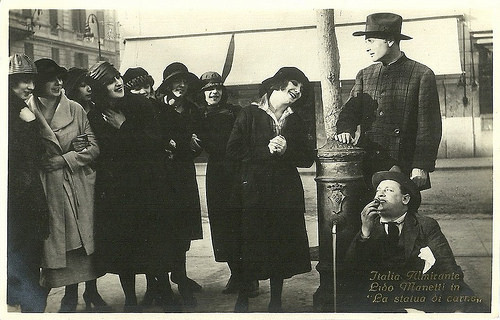
Italian postcard by G.B. Falci, Milano, no. 213. Italia Almirante , Bianca Renieri, Lido Manetti and Oreste Bilancia in La statua di carne (Mario Almirante, 1921). After a wild night of slumming to chase the bad experience of his infidel upper-class girlfriend, count Paolo di Santa Flora (Manetti) with his rotund friend (Bilancia) meet early in the morning a group of lower-class girls going to work. Among them Maria (Almirante) and her friend (Renieri). The girls adopt the men, thinking they are poor artists, and offer them breakfast.
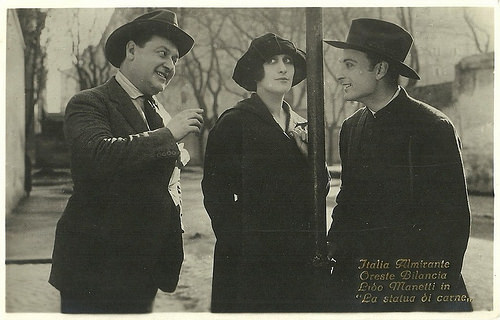
Italian postcard by G.B. Falci, Milano, no. 215. Oreste Bilancia, Italia Almirante and Lido Manetti in La statua di carne (Mario Almirante, 1921). After their first meeting, Paolo continues the charade to stay close to Maria. He pretends to be a poor artist. His friend knows why.
Different versions
La statua di carne/The statue of flesh was based on a stage play by Theobald Ciconi, which was adapted by Luciano Doria. The 1862 play had already been brought twice to the screen. The earlier film versions date from 1912 and 1919.
In 1943 director Camillo Mastrocinque implemented a new, naturalistic film edition of the play, La statua vivente/The Living Statue. The leads were played by Fosco Giachetti and Laura Solari .
A restored version of 67 minutes of La statua di carne (1921) was presented to the Pordenone Silent Film Festival of 1991. Another version of 75 minutes was presented by the Bologna Cinematheque at the Cinema Ritrovato festival 2010. Originally, the film was about 80 minutes.
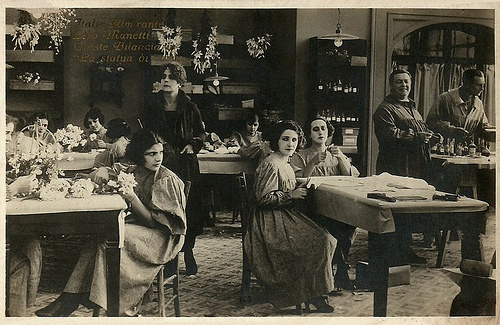
Italian postcard by G.B. Falci, Milano, no. 220. Bianca Renieri, Italia Almirante Manzini, Oreste Bilancia and Lido Manetti in the film La statua di carne (Mario Almirante, 1921). Rich but bored Count Paolo (Manetti) and his equally well-to-do friend (Bilancia) pretend to be quite penniless, in order to stay close to the girls of the flower making atelier, in particular Maria (Almirante) and her friend (Renieri). The men even assist in the shop. From the extreme right to the left, this picture shows Manetti, Bilancia, Almirante and Renieri working in the shop.
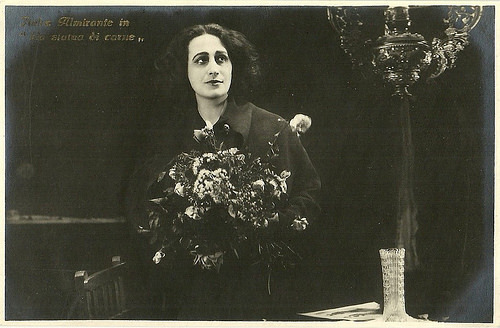
Italian postcard by G.B. Falci, Milano, no. 104. Photo: La Fotominio. Italia Almirante in La statua di carne (Mario Almirante, 1921). Maria secretly visits Paolo's apartment next-door and brings him flowers.
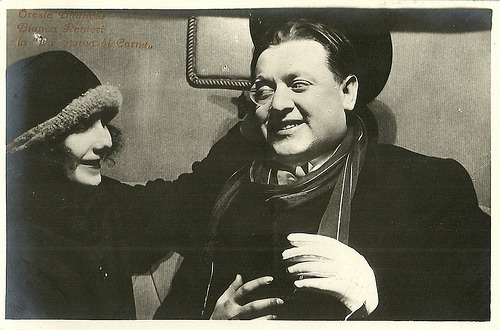
Italian postcard by G.B. Falci, Milano, no number. Photo: La Fotominio. Oreste Bilancia and Bianca Renieri in La statua di carne (Mario Almirante, 1921). Paolo's friend reveals to Maria's friend he is not a poor bum but a wealthy aristocrat.
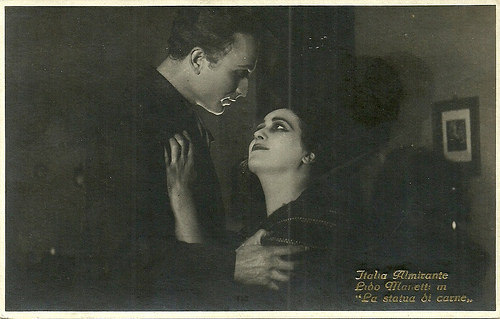
Italian postcard by G.B. Falci, Milano, no. 243. Italia Almirante and Lido Manetti in La statua di carne (Mario Almirante, 1921). Poor Maria is deeply in love with Paolo, at first unknowing he is a count who pretends to be a poor artist. She will die of tuberculosis, in the hands of Paolo.
The four main stars
Italia Almirante Manzini (1890-1941) was one of the divas of the Italian silent cinema. She starred in the classic epic Cabiria (1914).
Lido Manetti a.k.a. Arnold Kent (1899-1928) was an Italian actor who first had a prolific career in Italian silent cinema. Brought to America as a young leading man, he died before living up to his promise.
Bianca Renieri (?-1985) had a short but fruitful career in Italian silent cinema in the early 1920s. She worked as a supporting actress and antagonist opposite Francesca Bertini in La ferita (1920), Maddalena Ferat (1920), and Ultimo sogno (1924). Opposite Italia Almirante Manzini , she also appeared in I tre amanti (1921), Marthù che visto il diavolo (1921) and La maschera del male (1922). She also acted in films with Linda Pini and Diomira Jacobini , in the propaganda film Il grido dell'aquila (Mario Volpe 1923) and the Za-la-mort crime film Quale dei due? (Emilio Ghione, 1922). Her last part was the female lead in Contessina (Arturo Gallea, 1925).
Oreste Bilancia (1881-1945) was an Italian stage and film actor, who was highly active in Italian silent and sound cinema and German late silent film. He mostly worked as supporting actor, but occasionally he played the lead.
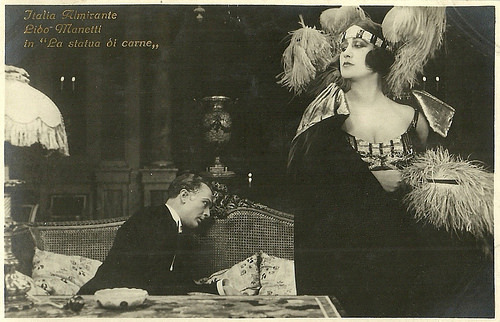
Italian postcard by G.B. Falci, Milano, no. 94. Photo: La Fotominio. Italia Almirante and Lido Manetti in La statua di carne (Mario Almirante, 1921). Count Paolo's first night back in society after Maria's death provides him with a shock. He meets an elegant masked lady, Noemi Keller, the toast of the town. She agrees to cheer him up. In a room in the theatre she takes off her mask and proves to be the spitting image of Maria.
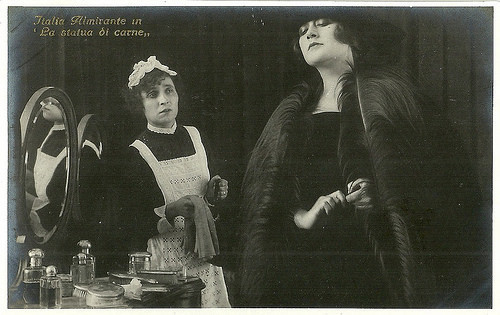
Italian postcard by G.B. Falci, Milano, no. 250. Italia Almirante in La statua di carne (Mario Almirante, 1921). Rich, mundane and femme fatale Noemi Keller considers the offer done to her by count Paolo: to live in a splendid villa and in recompense sit in front of him one hour every day.
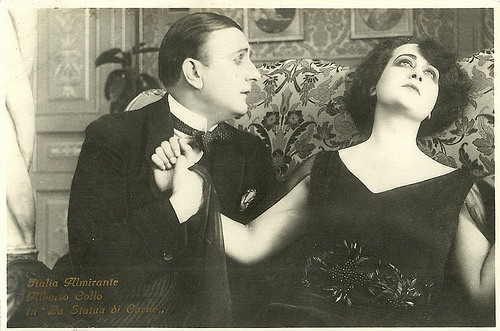
Italian postcard by G.B. Falci, Milano, no. 47. Photo: Fotominio. Italia Almirante and Alberto Collo in La statua di carne (Mario Almirante, 1921). Noemi Keller's old flame begs her to give up her charade for Paolo, sitting each day like a statue in front of him, as she is the spitting image of his lost love Maria. But Naomi cannot give up, as she is developing a crush for Paolo.
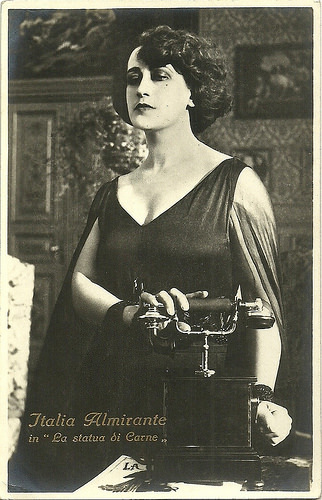
Italian postcard by G.B. Falci, Milano. Italia Almirante in La statua di carne (Mario Almirante, 1921). Noemi considers whether she should stop the charade for Paolo.
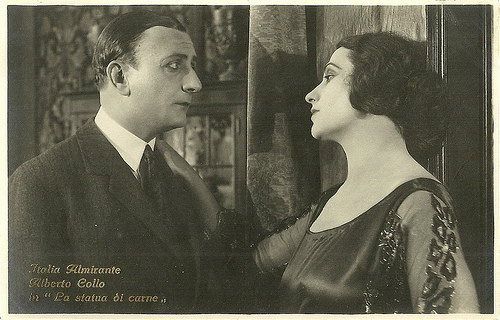
Italian postcard by G.B. Falci, Milano, no. 99. Italia Almirante and Alberto Collo in La statua di carne (Mario Almirante 1921). Noemi Keller's old flame tries her to give up her golden cage and get back to society life, but she refuses.
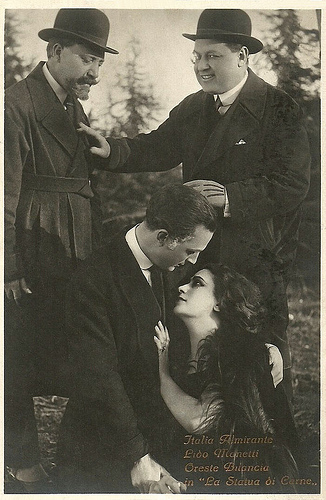
Italian postcard by G.B. Falci, Milano, no. 49. Photo: Fotominio. Italia Almirante Manzini, Lido Manetti and Oreste Bilancia in the closing scene of La statua di carne (Mario Almirante, 1921). Paolo has fought a duel with Noemi's former lover. Noemi's goes berserk when seeing the duel and throws herself in Paolo's arms. He then finally recognizes her as herself and not anymore as the lookalike, and opens his heart to her too. Diplomatically, Paolo's friend takes the doctor away, leaving the couple to themselves.
Sources: Wikipedia (Italian) and IMDb.

Italian postcard by G.B. Falci, Milano, no. 213. Italia Almirante , Bianca Renieri, Lido Manetti and Oreste Bilancia in La statua di carne (Mario Almirante, 1921). After a wild night of slumming to chase the bad experience of his infidel upper-class girlfriend, count Paolo di Santa Flora (Manetti) with his rotund friend (Bilancia) meet early in the morning a group of lower-class girls going to work. Among them Maria (Almirante) and her friend (Renieri). The girls adopt the men, thinking they are poor artists, and offer them breakfast.

Italian postcard by G.B. Falci, Milano, no. 215. Oreste Bilancia, Italia Almirante and Lido Manetti in La statua di carne (Mario Almirante, 1921). After their first meeting, Paolo continues the charade to stay close to Maria. He pretends to be a poor artist. His friend knows why.
Different versions
La statua di carne/The statue of flesh was based on a stage play by Theobald Ciconi, which was adapted by Luciano Doria. The 1862 play had already been brought twice to the screen. The earlier film versions date from 1912 and 1919.
In 1943 director Camillo Mastrocinque implemented a new, naturalistic film edition of the play, La statua vivente/The Living Statue. The leads were played by Fosco Giachetti and Laura Solari .
A restored version of 67 minutes of La statua di carne (1921) was presented to the Pordenone Silent Film Festival of 1991. Another version of 75 minutes was presented by the Bologna Cinematheque at the Cinema Ritrovato festival 2010. Originally, the film was about 80 minutes.

Italian postcard by G.B. Falci, Milano, no. 220. Bianca Renieri, Italia Almirante Manzini, Oreste Bilancia and Lido Manetti in the film La statua di carne (Mario Almirante, 1921). Rich but bored Count Paolo (Manetti) and his equally well-to-do friend (Bilancia) pretend to be quite penniless, in order to stay close to the girls of the flower making atelier, in particular Maria (Almirante) and her friend (Renieri). The men even assist in the shop. From the extreme right to the left, this picture shows Manetti, Bilancia, Almirante and Renieri working in the shop.

Italian postcard by G.B. Falci, Milano, no. 104. Photo: La Fotominio. Italia Almirante in La statua di carne (Mario Almirante, 1921). Maria secretly visits Paolo's apartment next-door and brings him flowers.

Italian postcard by G.B. Falci, Milano, no number. Photo: La Fotominio. Oreste Bilancia and Bianca Renieri in La statua di carne (Mario Almirante, 1921). Paolo's friend reveals to Maria's friend he is not a poor bum but a wealthy aristocrat.

Italian postcard by G.B. Falci, Milano, no. 243. Italia Almirante and Lido Manetti in La statua di carne (Mario Almirante, 1921). Poor Maria is deeply in love with Paolo, at first unknowing he is a count who pretends to be a poor artist. She will die of tuberculosis, in the hands of Paolo.
The four main stars
Italia Almirante Manzini (1890-1941) was one of the divas of the Italian silent cinema. She starred in the classic epic Cabiria (1914).
Lido Manetti a.k.a. Arnold Kent (1899-1928) was an Italian actor who first had a prolific career in Italian silent cinema. Brought to America as a young leading man, he died before living up to his promise.
Bianca Renieri (?-1985) had a short but fruitful career in Italian silent cinema in the early 1920s. She worked as a supporting actress and antagonist opposite Francesca Bertini in La ferita (1920), Maddalena Ferat (1920), and Ultimo sogno (1924). Opposite Italia Almirante Manzini , she also appeared in I tre amanti (1921), Marthù che visto il diavolo (1921) and La maschera del male (1922). She also acted in films with Linda Pini and Diomira Jacobini , in the propaganda film Il grido dell'aquila (Mario Volpe 1923) and the Za-la-mort crime film Quale dei due? (Emilio Ghione, 1922). Her last part was the female lead in Contessina (Arturo Gallea, 1925).
Oreste Bilancia (1881-1945) was an Italian stage and film actor, who was highly active in Italian silent and sound cinema and German late silent film. He mostly worked as supporting actor, but occasionally he played the lead.

Italian postcard by G.B. Falci, Milano, no. 94. Photo: La Fotominio. Italia Almirante and Lido Manetti in La statua di carne (Mario Almirante, 1921). Count Paolo's first night back in society after Maria's death provides him with a shock. He meets an elegant masked lady, Noemi Keller, the toast of the town. She agrees to cheer him up. In a room in the theatre she takes off her mask and proves to be the spitting image of Maria.

Italian postcard by G.B. Falci, Milano, no. 250. Italia Almirante in La statua di carne (Mario Almirante, 1921). Rich, mundane and femme fatale Noemi Keller considers the offer done to her by count Paolo: to live in a splendid villa and in recompense sit in front of him one hour every day.

Italian postcard by G.B. Falci, Milano, no. 47. Photo: Fotominio. Italia Almirante and Alberto Collo in La statua di carne (Mario Almirante, 1921). Noemi Keller's old flame begs her to give up her charade for Paolo, sitting each day like a statue in front of him, as she is the spitting image of his lost love Maria. But Naomi cannot give up, as she is developing a crush for Paolo.

Italian postcard by G.B. Falci, Milano. Italia Almirante in La statua di carne (Mario Almirante, 1921). Noemi considers whether she should stop the charade for Paolo.

Italian postcard by G.B. Falci, Milano, no. 99. Italia Almirante and Alberto Collo in La statua di carne (Mario Almirante 1921). Noemi Keller's old flame tries her to give up her golden cage and get back to society life, but she refuses.

Italian postcard by G.B. Falci, Milano, no. 49. Photo: Fotominio. Italia Almirante Manzini, Lido Manetti and Oreste Bilancia in the closing scene of La statua di carne (Mario Almirante, 1921). Paolo has fought a duel with Noemi's former lover. Noemi's goes berserk when seeing the duel and throws herself in Paolo's arms. He then finally recognizes her as herself and not anymore as the lookalike, and opens his heart to her too. Diplomatically, Paolo's friend takes the doctor away, leaving the couple to themselves.
Sources: Wikipedia (Italian) and IMDb.
Published on February 06, 2015 22:00
Paul van Yperen's Blog
- Paul van Yperen's profile
- 13 followers
Paul van Yperen isn't a Goodreads Author
(yet),
but they
do have a blog,
so here are some recent posts imported from
their feed.



